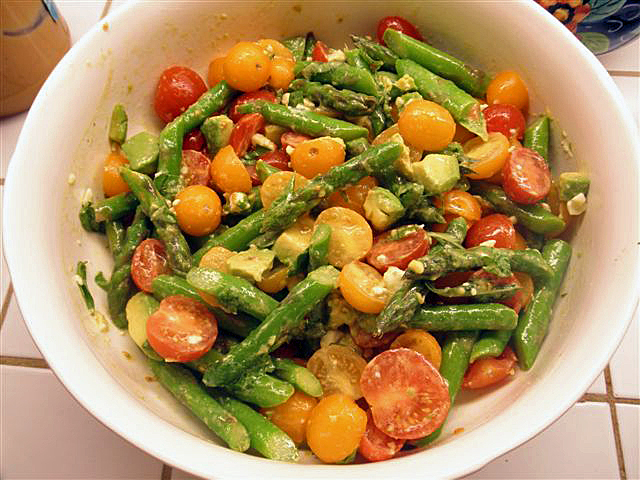
Ingredients
slightly overripe peaches 2
Plums 3
Khoya/mawa,grated 2 cups
Sugar1/4 cup
Mixed nuts,finely chopped as required
Green cardamom powder 1/4 teaspoon
Ghee for greasing
Method :- Servings: 4
- Cooking Time: 10-15 minutes
- Preparation Time: 10-15 minutes
- Step1: Peel peaches and chop them finely.
- Step 2: Finely chop plums.
- Step 3: Heat a non-stick pan, add khoya, sugar and green cardamom powder and cook till khoya melts and sugar dissolves.
- Step 4: Grease a tray with ghee.
- Step 5: Spread some of the nuts over it.
- Step 6: When the khoya melts, add plums and peaches and mix till well blended.
- Step 7: Spread this mixture in the tray over the nuts and sprinkle the remaining nuts over it.
- Step 8: Place the tray in the refrigerator and allow it to set.
- Step 9: When burfi sets, cut and serve.

Ingredients
White peas,sprouted 1/2 cup
Brown chane,sprouted Boiled 1/2 cup
Green chana(hare chane),sprouted Boiled 1/2 cup
Fresh coriander leaves 2 tablespoons
Saltto taste
Red chilli powder 1/2 teaspoon
Chaat masala 1/2 teaspoon
Cumin powder 1/2 teaspoon
Oil to shallow fry
Rice flour 1/2 cup
Method :- Servings: 4
- Cooking Time: 10- 15 minutes ,
- Preparation Time: 10-15 minutes
- Step1: Chop coriander leaves finely and place in a bowl.
- Step 2: Add white peas, brown chana, green chana, salt and mash with a potato masher.
- Step 3: Add red chilli powder, chaat masala, cumin powder and mix.
- Step 4: Heat a little oil in a non-stick pan.
- Step 5: Shape the mixture into small cutlets, roll them in rice flour and place in the pan to shallow fry.
- Step 6: When the underside is done, flip over and cook till both sides are evenly golden.
- Step 7: Serve hot with tomato ketchup or green chutney.
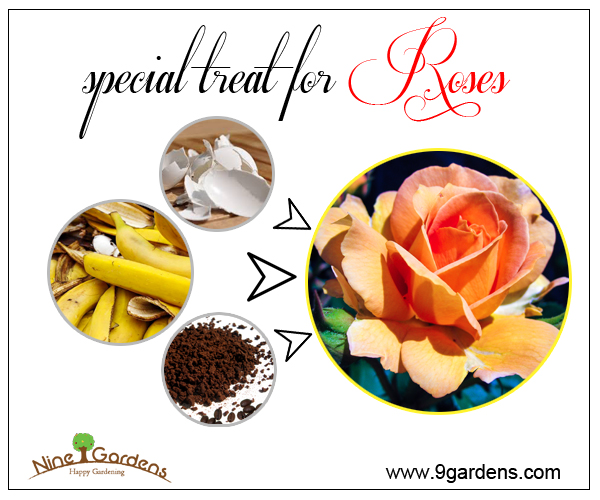
Special Treat for Roses: Natural growth boosters for your lovely Roses
Plant your Roses in a well- drained soil that's rich in organic matter, at a spot where it receives good amount of sunlight.
To get the most out of your rose plants and to have an awe-inspiring rose garden, you need not be an expert. Plant your Roses in a well- drained soil that's rich in organic matter, at a spot where it receives a good amount of sunlight.
Make sure roses get about 2 inches of water a week, depending on your soil type.
Banana Treat
Fresh banana peels are a healthy addition to your roses. They release beneficial minerals such as potassium, sulfur, calcium, magnesium and some phosphates into the soil. Bury your banana peels under your rose bushes so that they can relish the nutrients. Throw down the peel, and then cover it. No need to dig down and bury them deep.
Coffee Regale
Use your coffee grounds (the residue remaining after brewing coffee) to feed your plants, especially nitrogen-loving ones like camellias, hydrangeas, and roses. Not only will you have healthier plants you’ll also save money on fertilizer. This can also reduce pests in the garden.
Energy Booster
As they break down, eggshells act like a natural fertilizer, providing plants with valuable nutrients. Eggshells provide a valuable source of calcium for growing plants
Benefits -
Soils are often deficient in the essential elements necessary for optimum rose plant growth. Rose fertilizers work by adding back into the soil these necessary nutrients.
]]>
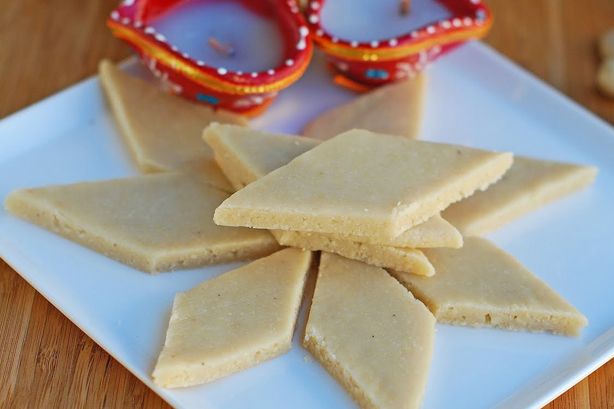
Ingredients
1 cup (200 grams) broken cashewnuts (kaju)
1/2 cup (50 grams) sugar
1/2 tsp cardamom (elaichi) powder
Method :- Preparation Time: 10 mins
- Cooking Time: 10 mins
- Makes 10 servings
- Step1: Grind the cashewnuts to a fine powder.
- Step 2: In a non-stick pan, dissolve the sugar in ½ cup of water and heat to prepare a syrup of one string consistency.
- Step 3: Add the cashew powder and cook over a medium flame, stirring continuously till the mixture leaves the sides of the pan (approx. 10 to 12 minutes).
- Step 4: Transfer to a plate and cool slightly.
- Step 5: Knead gently and press them into greased chocolate moulds.
- Step 6: Unmould and serve.

Ingredients
1/2 cup butter
1 1/4 cups heavy cream
1 cup superfine sugar
4 bananas, peeled and halved lengthwise
Method :- 4 servings
- Step1: Melt butter in a large, heavy skillet over medium heat.
- Step 2: Stir in sugar and cook, stirring, until sugar is melted and light brown.
- Step 3: Slowly stir in the cream (mixture will bubble up).
- Step 4: Let mixture boil 1 minute, then reduce heat to low.
- Step 5: Place the bananas in the pan and cook until heated through, about 2 minutes.
- Step 6: Serve hot.

Ingredients
For rotis:
2 cups wheat flour
1/2 cup maida
1/2 tsp turmeric
1 tsp cumin powder
3 tbsp oil
Salt to taste
Water for the dough
For Filling:
2 cups - paneer, cubed
2 cups - potato, boiled and cubed
3 tsp - tamarind paste
4 - shallots, chopped
4 - garlic cloves, chopped
1/2 tsp cumin seeds
1/2 tsp turmeric powder
2 tsp - red chilli powder
1 tsp garam masala
1 tsp cumin powder
Salt to taste
4 tbsp oil
Method :- Step1: Combine flours, turmeric powder, cumin powder, salt with oil and water to make a soft dough.
- Step 2: Keep aside for an hour.
- Step 3: Heat oil in pan, add cumin seeds, shallots, garlic, and saute for 2-3 min.
- Step 4: Now add boiled potato cubes, paneer cubes, salt, turmeric powder, red chilli powder, cumin powder and garam masala.
- Step 5: Stir well ans sprinkle some water.
- Step 6: Cook covered for 5 minutes on medium-low heat, stirring occasionally.
- Step 7: Add the tamarind paste and cook for 2 minutes.
- Step 8: Make rotis out of the dough.
- Step1: Place the rotis on a flat surface and put a spoonful of potato and paneer curry.
- Step 2: Fold the edges from all sides except one.
- Step 3: Heat some oil on a tawa and place the frankie on it.
- Step 4: Cook until brown spots appear on both sides.
- Step 5: Serve hot with tomato ketchup.
- Tip: Frankies get soggy after a while, so serve hot.
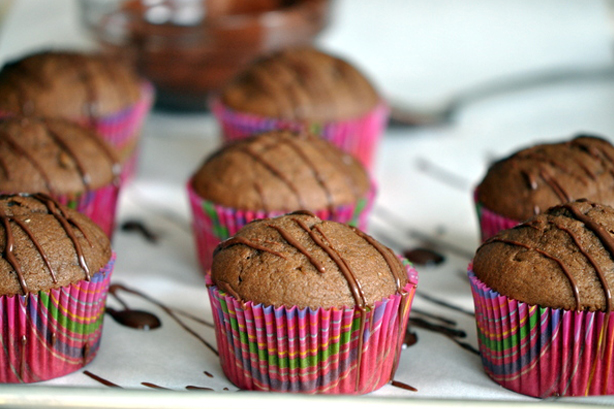
Ingredients
2 eggs
1 cup milk
¼ cup banana (about 1 banana), mashed with a fork
¼ cup peanut butter
1/3 cup vegetable oil
¼ cup frozen apple juice concentrate
¼ cup nonfat dry milk
2¼ cup flour
1½ tsp. baking powder
1 tsp. baking soda
Method :- Step1: Preheat oven to 350° F (180° C).
- Step 2: In a small bowl, break the eggs and use a fork to beat them a little bit.
- Step 3: In a large bowl,combine the milk,mashed banana,peanut butter, vegetable oil, apple juice, dry milk, and the eggs from the small bowl.
- Step 4: Mix with a mixing spoon until the mixture is creamy.
- Step 5: Add the flour, baking powder, and baking soda into the large bowl.
- Step 6: Mix again.
- Step 7: Line a muffin tine with paper liners or lightly spray with nonstick spray.
- Step 8: Spoon in the muffin mix.
- Step 9: Fill each muffin cup about 2/3 of the way up.
- Step 10: Bake for about 15 minutes.
- Step 11: When your muffins are finished baking, remove from muffin tin and cool them on the wire rack.
- Step 12: Then it's time to taste and share!

Vermicomposting: The magic of the worms
Vermicomposting is the process of using worms and micro-organisms to turn kitchen waste into nutrient-rich humus.
Next time you find Earthworms or Red wrigglers, don’t kill them rather put them back in the soil and let them convert pieces of organic matter like vegetable wastes and dead leaves into rich humus and thus improve your soil’s fertility.
Vermicomposting is the process of using worms and micro-organisms to turn kitchen waste into a black, earthy-smelling, nutrient-rich humus.Worms turn organic waste into worm castings. These worm castings, combined with partially processed organic matter, form vermicompost.
Benefits -
Composting with worms not only benefits the environment, but also provides a fun experience of producing natural organic fertilizer at home.
Results in nutrient-rich humus which is beneficial for plants.
]]>
Using your Pet's Hair in garden: Adding Nitrogen to the Soil
Pet's hair is a beneficial additive to compost
Is your pet shedding profusely? Wondering where to dump the pile of hair that the pet sheds?
Your dog’s hair is a beneficial additive to compost. The excess hair brushed from your pet or even the clippings of your own hair can be used as mulch or may even go into the compost pile.
It can actually contribute the much-needed nitrogen to the soil. Due to the high protein content, hair may take a long time to decompose.To extenuate the time it takes to break down, you can cut the hair into ½- 1 inch sections before adding them to the compost pile.
Benefits -
The hair from humans and animals is composed of proteins and nitrogen, which plants need to thrive. When the hair eventually breaks down and decomposes, it creates an especially nitrogen-rich fertilizer for the garden.

Garden maintenance activity: Deadheading garden flowers
Remove spent flowers from your plants
Removing flowers from plants when they are fading or dead, not only keeps the plants looking attractive but also encourages more blooms.
Removing the spent flowers is an important garden maintenance activity. Allowing the faded flowers to stay on, will lead the plant to direct an enormous amount of energy towards developing seeds, to the point where root, foliage and flower production is negatively affected.
Benefits -
Deadheading flowers allows the plant to divert all the energy in better growth of the plant and additional flowers and you will be able to enjoy more blooms from a larger and healthier plant.
]]>

Tips for Nitrogen & Acid loving plants:
Energy Boosters
Did you just throw the tea bag after brewing tea? Save the used tea bags and coffee grounds for your plants. They help improve the plants overall health and growth.
Use coffee grounds to feed nitrogen and acid loving plants like camellias, hydrangeas and roses. Not only will you have healthier plants but also, save money on fertilizer. Coffee can also help reduce slugs in the garden.
Benefits of Used tea bags-
Used tea bags placed in the soil around the plants, helps retain the moisture and protects the soil from drying out between waterings.
Tea grounds (the residue remaining after brewing coffee) increase nutrient levels and improve soil quality as they decompose. Thus they prove to be great plant supplements and make great addition to compost piles.
Tannic acid in tea is great for acid-loving plants like roses and ferns.
]]>

Ingredients
To Be Mixed Into A Paneer Stuffing:
1 cup grated paneer
1/4 cup grated carrot
1/4 cup boiled and lightly mashed green peas
1/2 tsp chilli powder
1/4 tsp turmeric powder (haldi)
1 tbsp finely chopped coriander (dhania)
Salt to taste
To Be Mixed Into A Smooth Batter:
3/4 cup besan (Bengal gram flour)
1/3 cup water
1/4 tsp turmeric powder (haldi)
1/4 tsp chilli powder
A pinch asafoetida (hing)
Salt to taste
4 whole wheat bread slices
Oil for deep-frying
Method :- Makes 4 pakodas
- Preparation Time:10 mins, Cooking Time: 10 mins
- Step1: Divide the stuffing into 4 equal portions and keep aside.
- Step 2: Place a slice of bread on a clean, dry surface and spread a portion of the stuffing evenly over it.
- Step 3: Place another slice of bread over it, press lightly and cut it diagonally into 2 equal pieces.
- Step 4: Repeat with the remaining ingredients to make 2 more pieces.
- Step 5: Dip each piece in the batter till it is evenly coated from all the sides, slide in hot oil and deep-fry on a medium flame till the pakodas turn light brown in colour and crisp from both the sides.
- Step 6: Drain on absorbent paper.

Ingredients
3/4 cup (100 grams) besan (Bengal gram flour), coarsely ground
3/4 cup (100 grams) powdered sugar
1/3 cup (60 grams) ghee
1/4 tsp cardamom (elaichi) powder
2 to 3 drops saffron colour
Method :- Make 7 laddus.
- Preparation Time: 5 mins, Cooking Time:10 mins.
- Step1: Mix together the sugar and saffron colour and keep aside.
- Step 2: Melt the ghee in a kadhai, add the gram flour and cook over a low flame stirring continuously till it is golden brown in colour.
- Step 3: Add the cardamom powder and mix well.
- Step 4: Remove from the fire and pour onto a plate (thali). Cool completely.
- Step 5: Mix together the gram flour mixture and sugar.
- Step 6: Divide into 7 equal portions and shape into laddus.
- Tips .You can use regular gram flour instead of the coarsely ground gram flour for the above recipe.
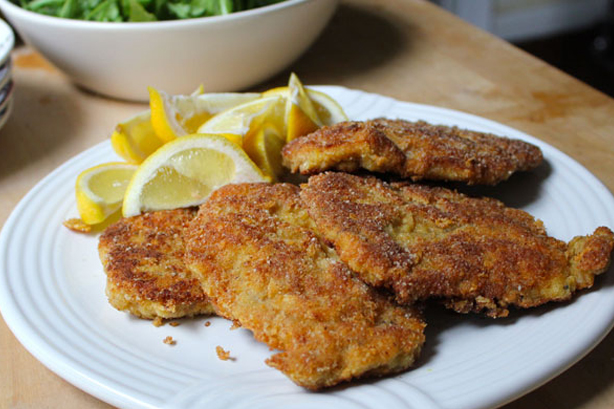
Ingredients
1 1/2 cups cooked instant noodles
1/2 cup sweet corn (makai ke dane), cooked and crushed
2 green chillies, finely chopped
2 spring onions, finely chopped
3 tbsp tomato ketchup
1/2 cup grated processed cheese
1/2 cup bread crumbs
Salt to taste
Black pepper (kalimirch) powder to taste
Bread crumbs for coating
Oil
Method :- Make 12 cutlets.
- Preparation Time : : 10 mins, Cooking Time : : 15 mins.
- Step1: In a bowl, combine the noodles, sweet corn,green chillies, spring onions, ketchup, cheese, bread crumbs, salt and pepper and mix well using your hands.
- Step 2: Divide the mixture into 12 equal portions and shape into cutlets.
- Step 3: Coat the cutlets with dried bread crumbs and shallow fry in oil on both sides till golden brown.
- Step 4: Serve hot with ketchup or green chutney.

Ingredients
4 tablespoons plain flour
225ml semi skimmed milk
1 pinch salt
3 eggs (medium sized)
1/2 teaspoon ground cinnamon
1 teaspoon vanilla essence
1 tablespoon caster sugar
12 thick slices bread
Method :- Serves: 12
- Prep:10min › Cook:20min › Ready in:30min
- Step1: Measure flour into a large mixing bowl.
- Step 2: Slowly whisk in the milk.
- Step 3: Whisk in the salt, eggs, cinnamon, vanilla essence and sugar until smooth.
- Step 4: Heat a lightly oiled frying pan over medium heat.
- Step 5: Soak bread slices in mixture until saturated.
- Step 6: Cook bread on each side until golden brown.
- Step 7: Serve hot.

Mulching has a wide range of benefits which most of us are unaware of. It can be described as the most economical and intelligent way to get rid of the tedious task of pulling out weeds from your garden and keeping your plants healthy and glowing, so that you can get more time to enjoy your yard. Covering the soil helps to keep it moist for longer time, so you have to spend much less time watering the soil. Proper mulching not only helps conserve water but also shields your plants' roots from temperature extremes and discourages the growth of weeds.
Let us now have a deeper look, into the process and its beneficial outcomes.Mulching is basically divided into two types-Organic and Inorganic.
Organic mulches include formerly living material such as chopped leaves, twigs, paper, straw, grass clippings, wood chips, shredded bark, sawdust, compost etc.
Shredded leaves, grass clippings and compost are best mulching materials for your vegetable gardens, as they are nutrient and nitrogen rich mulches which can improve the soil quality as they decompose.
Grass clippings and fallen leaves are the best easily available mulching materials, which can be readily obtained from your own garden.
Inorganic mulches include gravel, stones, pebbles or black plastic.
Decorative gravel and stone mulches not only add colour and texture to the space between the plants but also provides a neat look and doesn’t get washed away easily, thus it need not be replenished from time to time.
Black plastic mulches are good for plants like tomato, pepper, brinjal, watermelons and pumpkins which prefer warm soil.
The two important things you should keep in mind while mulching are-
- Lay the mulch after the soil has been cleared of all the weeds
- Lay a thick layer of 2-3 inch, so that new weeds cannot come out through the layer of mulch. Do not try to overdo the layer as it may suffocate the roots.
There are certain other things which you must be knowing before starting with the mulching-
- When Low-nitrogen organic mulches such as wood chips and sawdust decay, nitrogen is temporarily depleted from the soil. So it is necessary that you fertilize the soil first, with a high-nitrogen product to boost soil nitrogen levels.
- Mulch heaped up against woody stems of plants, can cause them to rot as they decompose. So it is preferable to leave some space between the stem and the layer of mulch, probably a 2 inch gap between the two.
Spend some time to spread a layer of mulch in your yard to enjoy the benefits.
]]>
Ingredients
1 (500g) pack fusilli pasta
2 tablespoons extra virgin olive oil
75g oil-cured olives, pitted and chopped
Handful minced fresh oregano
Handful chopped fresh parsley
1 bunch green onions, chopped
400g safed chane (chickpeas), soaked overnight and boiled or 1 can, drained
4 tablespoons red wine vinegar
50g grated Parmesan cheese
Salt and freshly ground black pepper to taste
Method :- Serves: 6
- Prep: 15min › Cook:35min › Ready in:50min
- Step1: Bring a large pot of salted water to a boil, add pasta and cook until al dente.
- Step 2: Drain and rinse under cold water.
- Step 3: Set aside to chill.
- Step 4: In a large frying pan, heat the olive oil over medium low heat.
- Step 5: Add the olives, oregano, parsley, green onions and chana.
- Step 6: Reduce heat to low and cook for about 20 minutes.
- Step 7: Set aside to cool.
- Step 8: In a large bowl, toss the pasta with the chana mixture.
- Step 9: Add the vinegar, grated cheese and salt and pepper to taste.
- Step 10: Let sit in refrigerator overnight.
- Step 11: When ready to serve, taste for seasoning and add more vinegar, olive oil and salt and pepper if desired.
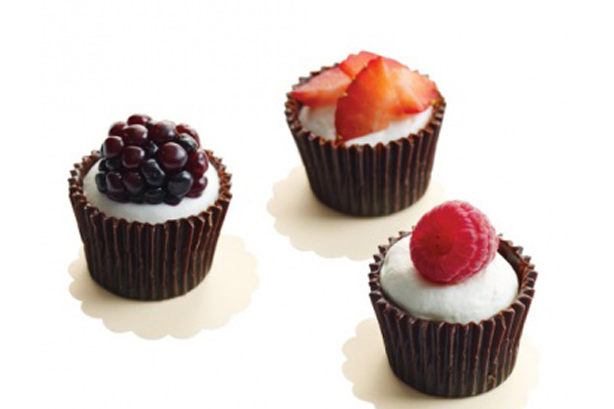
Ingredients
1 cup Cooking chocolate,grated
4 medium size Plastic cups
12 medium size Strawberries
1 cup Fresh cream
1/3 cup Powdered sugar
Method :- Seves: 4
- Prep:3hr › Cook:2min › Extra time:2min freezing › Ready in:3hr4min
- Step1: Melt chocolate either in a microwave or a double boiler.
- Step 2: Whisk it well.
- Step 3: Give a small cut on one side of the rim of the plastic cups.
- Step 4:Pour the melted chocolate inside the cups and swirl them so that the chocolate coats the cups entirely.
- Step 5: Pour out excess.
- Step 6: Keep the cups in the refrigerator to set.
- Step 7: Whip cream with powdered sugar till it stands in peaks
- Step 8: Quarter one strawberry and set aside.
- Step 9: Chop the rest and place them in a bowl.
- Step 10: Add most of the whipped cream and mix.

For many home gardeners, the tomato crop is often a source of pride.
The secret behind a healthy tomato plant and a wonderful produce, is to plant them at a spot where they receive ample amount of sunlight, at least four hours a day and water the plants properly.
Most other plants will not thrive if you plant them deeply, tomatoes are different. Roots will develop from stems that are under ground and your tomatoes will be stronger and healthier. Dig a hole, deep enough to keep most part of your plant covered by soil, making sure that you remove all the leaves below the soil line. Tomatoes do much better if they are mulched. Mulching not only inhibits the growth of weeds, which may curb the healthy growth of your tomato plants, but helps retain the moisture in the soil and also you don't have to spend hours pulling them out.
Tomatoes form roots up their stems and stalk if they are mulched. The more roots, the better they grow. So mulch right up to the stem if you can!
Plant them about half a meter apart; water them with a light spray from the hose or sprinkler — not a hard jet of water or you may damage them. Water every day or two till they're as high as your ankle and their roots are nicely established. It is preferable to water in the mornings (plants take up and use water more efficiently in the morning) and water the soil, not the plants.
The goal is to keep the soil moist, not wet. Too much water and your plant's roots will rot. Too little water and your plants will get weak and your tomatoes will get blossom end rot.
A simple way to ensure a larger number of picture-perfect tomatoes is to keep the fruit and foliage up off the ground. Tomato plants are susceptible to fungal diseases that are transmitted when infected soil splashes up onto the foliage during a rainfall. The fruit is more susceptible to slug and insect damage or rot if it is allowed to rest on or near the ground. This problem can be easily remedied by trellising your tomato plants to keep them up off the ground. Crushed egg shells strewn around your plants can help you get rid of slugs, as the sharp edges makes it difficult for slugs to crawl on.
You can easily make your own tomato cages with materials found at any hardware store. Woven or welded wire fencing makes great tomato cages. Choose fencing that has gaps between the wires large enough to reach through to pick your tomatoes. Use a wire cutter to cut the fencing to a length of about six feet, bend it into a tube shape and use pliers to bend the horizontal wires around the vertical wires from one end to the other end so the cage holds its shape. If you’re growing a large number of tomato plants in rows, you may wish to create a large-scale trellising system. You’ll need some heavy gauge wire and metal fence posts, often referred to as T-posts. At both ends of the row of plants, sink two posts into the ground, placing the posts about two feet apart, one on either side of your plants. Then attach the wire at two or three levels between the posts. As your tomato plants grow, they will be supported by the wires. If you have a particularly long row of tomato plants, you will want to add more posts along the length of the row so the wire doesn’t sag under the weight of the heavy plants. To avoid damaging the plants, it is best to place your tomato cages or trellis around the plants while they are still small. Particularly unruly plants can be loosely tied to the trellis or cage with twine.
As your tomato plants grow, you’ll notice that they send out new shoots above every leaf stem where it attaches to the main stem. These new shoots are called suckers, and each sucker is capable of growing into another stem on the plant and setting its own blossoms and fruit. Eventually the suckers will even grow their own suckers, making for a very full plant.
The first suckers that appear will be very low on the plant, generally from above the first sets of true leaves. Since they are so low on the plant, the fruit produced on these suckers will hang low to the ground and will be the most susceptible to slug damage or rot from contact with the soil. These first tomatoes are also the most likely to suffer from cat facing which is a type of scarring found on tomatoes that have formed while temperatures are cooler than tomatoes like.
Remove those first suckers that appear by pinching them off with your fingers before they get more than an inch or two long. If the suckers have grown longer before you can remove them, they can still be snapped off by hand, or you can use your favorite secateurs or pruners to snip them off.
Removing the first suckers on your plants will encourage the plant to send out even more suckers. You’ll want to leave most of these suckers on the plants so they can produce more tomatoes for you. But if your plants are becoming full to the point where you cannot see through to the center of the plant, you may want to remove a few suckers to promote better air circulation throughout the plant. Your tomato plants can expend their energy making lots of smaller tomatoes, but if they are limited to producing fewer tomatoes, those tomatoes will generally be larger.
As the growing season nears its end, your tomato plants will still be setting blossoms and growing fruit. But the fruit that is setting near the end of the season won’t have time to ripen before the first killing frost. Four weeks before the first frost date for your area you can start pinching off any new suckers and blossom sets that appear on your plants. Any fruit they may have produced wouldn’t have time to ripen before being killed by frost. This will allow your plants to put more of their energy into growing and ripening their existing fruit, rather than spending that energy on making more vegetative growth and blossoms that will never get a chance to develop into ripe fruit.
In addition to pruning and trellising your tomato plants, always apply a layer of mulch beneath the plants in early summer after the soil has warmed. The mulch will help hold moisture in the soil, discourage slugs and keep soil from splashing up onto your plants.
All the best for a great tomato growing experience.
]]>The nutritious, versatile vegetable, which is the world's favorite root vegetable, comes in innumerable varieties and is a staple in the diet of many people all over the planet. But before you run out to the garden with your shovel and hoe, there are a few things you should know about planting potatoes.
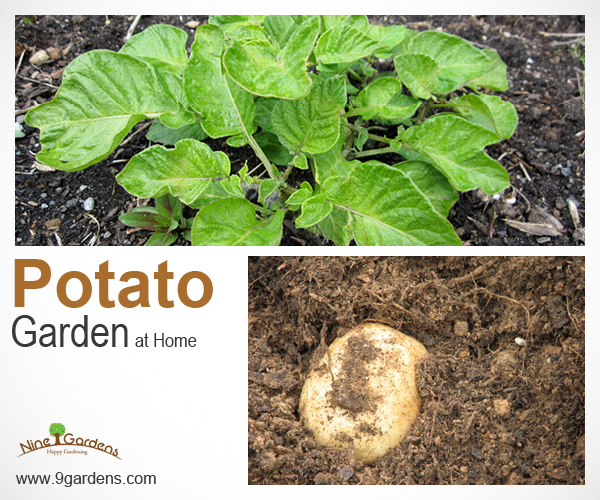
Potatoes can be grown easily from seed potatoes. A seed potato is nothing more than an ordinary potato, with at least one “eye”.
Seed potatoes can be planted whole, or they may be cut into pieces with at least one eye per piece. Seed potatoes with more eyes will grow to produce a larger quantity of potatoes but the potatoes will generally be smaller. Seed potatoes with fewer eyes will produce fewer potatoes, but those potatoes will tend to be larger.
If you choose to cut your seed potatoes into smaller pieces, divide them a day prior to planting. This allows the cuts to heal over slightly, which helps to prevent soil-borne diseases from infecting your potato crop. Always choose seed potatoes that are free from blemishes.
Plant your whole or cut seed potatoes two to three inches deep in good, rich soil. Rows of potatoes should be about three feet apart and the potatoes within the row should be planted twelve inches apart.
Potatoes like plenty of sun, so avoid planting them in frost-prone sites, as these conditions can damage the developing foliage.
Potato scab appears as rough patches on the skin of the potatoes. To control common scab, choose resistant cultivars and do not allow the soil to become dry during tuber development. Raise organic matter levels to improve water retention. Water the developing crop regularly.
Depending on the warmth of the soil, potato plants will begin to emerge from the soil anywhere from one to three weeks after planting. When the plants are about a foot tall, use your hoe to mound six to eight inches of soil continuously along the entire row of plants. This is called hilling. Hilling ensures that the potatoes will grow deeply under the soil, away from sunlight which would cause them to become green. Potatoes that suffer from greening will be bitter and the inedible green parts must be discarded.
Water your potato plants evenly while they are growing. A dry period followed by a rainy spell will cause some potato varieties to develop a hollow core.
The potato beetle is yet another problem which might affect the plants. The larvae and adult beetles will feed on the potato foliage, and a heavy infestation can damage the foliage enough to reduce your harvest considerably. Watch for the beetle’s yellow eggs on the undersides of leaves and crush the clusters whenever you see them. The larvae and adults can be picked off the leaves and crushed if there are only a few. An infestation can also be controlled with an organic pesticide which is safe to use.
Once your potato plants have bloomed, you can begin to harvest small “new” potatoes. Depending on the variety of potatoes you’re growing, this is about eight weeks after planting. In the fall, after the foliage has begun to dry and die back, the entire crop can be dug. Before storing them in a cool, dry and dark place, make sure the surface of your freshly dug spuds has dried a bit. Spread them out in a dry spot out of direct sun, such as a garage or shed, for a day or two before putting them in storage.
Freshly dug, crisp potatoes taste better than any you’ll buy at a grocery store. Grow some yourself and discover how easy and fun it is to produce a staple crop of delicious potatoes for your family.
Article Reference:
http://gardening-articles.com/35-lets%20plant%20potatoes%20in%20the%20garden.htm
]]>
Do’s
- Test your soil before sowing seeds or planting seedlings. Sow plants which may do well in the present soil condition or amend the soil to suit the plant requirement.
- Adopt organic farming method for your garden. Food produced organically is safer, fresh and simply delicious. Organically produced food is healthier because it minimizes exposure to synthetic pesticides and fertilizers.
- Prepare your garden soil to ensure maximum yield. It is better to conduct a soil test before fertilizing to estimate the nutrient requirements of your plants.
- Water your plants regularly. Water is required by plants for transpiration, photosynthesis and transporting nutrients throughout the plant body. Hence, you should provide water in adequate amounts to your plants.
- Encourage beneficial insects and worms like praying mantis, ladybugs and earthworms to come to your yard.
- Keep checking for indications which tell you about the plant’s watering requirements or its condition. Eg. If you notice that the leaves are drooping or the plant is starting to brown that is definitely a sign that your plants need water. Overwatering the plants may cause yellowing of leaves.
- Start plants according to the seasons and climatic conditions they grow in.
- Turn the plant occasionally so that it receives light on all sides to promote fuller growth in all directions.
- Repot your plants at least once a year
- Water your plants twice a day during summers
- Prune your plants occasionally to maintain their shape, to remove unwanted damaged parts and to promote new fresh growth.
- Keep checking your plants for signs of pest infestation.
- Use organic pest control products for your plants
- Mulching helps to reduce the amount of water that evaporates from your soil and acts as an insulating layer on top of soil, keeping it cooler in the summer and inhibits weed germination and growth.
Don'ts
- Do not work on your garden soil while it is wet. One should avoid working in the wet soil because it changes the soil structure.
- Do not scalp your lawn. Scalping allows the sunlight to reach the soil, allowing weed growth and burning humus in the soil. Hence, scalping is not recommended when it comes to gardening.
- Do not stake shrubs and trees . Staking the trees should be avoided as much as possible because the trunks of a staked shrub or tree are weaker and the root spread is also affected.
- Do not use synthetic pesticide sprays in your garden to allow least chemical exposure.
Keep these things in mind while you garden and perfect your gardening skills .
Composting is a simple, natural process that transforms the food scraps into valuable soil amendments. Segregate your household wastes into Organic, Recyclable and Rejects. The organic wastes can be turned into rich composts which you can use for your gardens.

Having an ample supply of compost is any gardeners' dream. Composting can serve many benefits for your garden. Many call it "black gold" because of the purposes it serves. It not only improves the soil texture, structure, aeration but also increases its water retention capacity and nourishes your plants. It prevents chemicals to go into the soil and improves the soil structure significantly. You can do your bit to save the environment by composting, because it lowers your carbon footprint. However, composting can be time consuming. Composting can take as long as a year or as little as 90 days, depending upon the amount of human control.
Most yard wastes can be composted, including leaves, grass clippings, plant stalks, vines, weeds, twigs and branches. Compostable food wastes include fruit and vegetable scraps, coffee grounds, eggshells and nutshells.Avoid including meat, fish, poultry, dairy products, diseased plants and weeds with developed seed heads in your compost bins. These items may cause odors, attract pests, or create unwanted mess.
To start with, you need a composting bin which will serve the purpose of holding the organic waste till it is converted into compost. A good composting procedure ensures minimum odor and mess. Place shredded papers, dead leaves, old newspapers etc. at the bottom of the bin. Try not to put more than 6” of each material on a layer. You don’t want 24” of grass clippings in the bin, you should alternate layers of green and brown material. If necessary, keep a few bags of dry leaves around so you can alternate layers of brown waste and green waste.
Not adding equal amounts of dried leaves, sawdust or paper makes the pile too wet and smelly and attracts a lot of flies. You have to put leaves in the same volume as your kitchen waste when you begin composting and later on adjust it to suite the moisture levels in the pile. Adding neem dust or turmeric powder to the pile helps check the repulsive maggots.
Once the bin is full, the rules of composting say that you should turn the material in the bin every few weeks. Not stirring at least once in a week leads in the pile to become compacted, wet and slimy and therefore smelly.
Some customers are so scared about moisture that they let the pile go very dry. Let us tell you that this stops composting totally. The microorganisms need moisture to live on and work. So make sure that the pile is moist, not soggy-but moist. This keeps the material damp, and the moisture will cause the pile to compost easily.
Sure this process is a little work, but it sure is nice to have a place to get rid of organic waste any time you like. When you have finished compost ready to add to your potting soil, you will be grateful to have done the right thing earlier, and you'll know that you have wasted nothing.
]]>
Ingredients
Pie dough
150 g dairy-free margarine
300 ml spelt flour or wheat flour
2 tbsp ice cold water
Fillings
400 g chanterelles
1½ tbsp dairy-free margarine
1-2 garlic cloves
150 g tofu
250 ml soy cream
Salt
Black pepper
Method :- Serving: 4 People
- Step1: Heat the oven to 200°C.
- Step 2: Mix flour and margarine in a bowl.
- Step 3: Add two spoonfuls of ice cold water and quickly knead into a dough.
- Step 4: If the dough feels too loose, store it in the fridge for 30 minutes.
- Step 5: Press the dough into a pie plate (about 24 cm in diameter), and pierce it with a fork to prevent bubbles.
- Step 6: Pre-bake the pie crust in the oven for 10-15 minutes.
- Step 7: Heat the cleaned chanterelles in a frying pan, adding the margarine when all the water has evaporated.
- Step 8: Sauté the chanterelles until they get some color.
- Step 9: Crush the garlic into the pan and stir carefully.
- Step 10: Mix tofu and soy cream in a blender or food processor, until it’s creamy.
- Step 11: Put the chanterelles in the pie crust and pour the tofu mix over. Bake for 30 minutes.
- Step 12: Garnish with fresh oregano or thyme.
- In this vegan recipe, tofu and soy cream replace eggs and cheese. You can use this base for any number of different vegan pies. Try replacing the chanterelles with vegetables, or another type of mushroom.
Grafting is the art of attaching two genetically distinct plants and thus enabling them to grow as a new plant. Scion is that part of the union, which is to be attached to the rootstock whereas; Stock is that part of the union which contains the root.
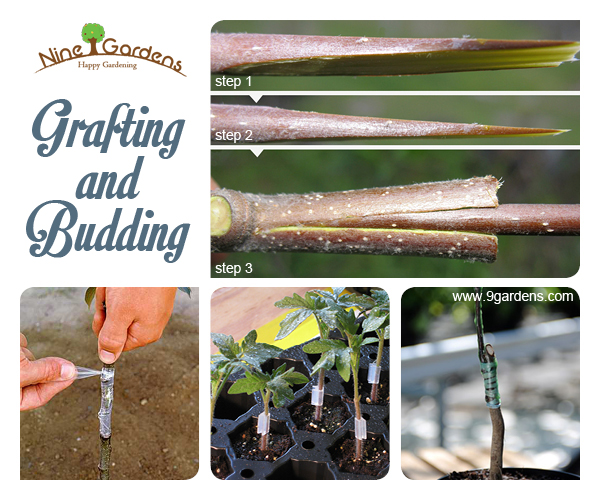
Image Courtesy: turkeysong.wordpress.com
Grafting is usually done because the desired plant is extremely difficult if not impossible to propagate through other means. There are numerous benefits of grafting different species of plants.
First and foremost grafting onto a strong, resistant rootstock can make is possible to grow a plant susceptible to root nematodes. It helps to induce cold tolerance or other characteristics to the scion.Grafting the scion of a new plant onto established plants greatly cuts down on the time it takes for the plants to flower and grow fruit.
Grafting lets you change the variety of the fruits or flower plants you're growing. You can graft the scion of the new variety fruit onto the rootstock of an existing fruit tree. The existing roots will grow the new variety as long as the scion and rootstock are compatible.
The most common grafting technique is -
Cleft grafting- this is the most common form of grafting where we make a small cut in the stalk and then insert the pointed end of the scion in the stalk. The stock should be split carefully down the middle to form a cleft and the end of the scion should be cut cleanly to a long shallow wedge. After this being done, it is time to slide the wedge into the cleft and then bind the stock with a tape to hold the scion in place. It is preferable to cover the grafted area with some sealing compound. This stops the cambium layers from drying out and also prevents water from seeping into the cleft.
Grafting roses is the most common example of bud grafting. Bud grafting is one in which we use a bud instead of a twig. In this method a bud is removed from the parent plant, and the base of the bud is inserted beneath the bark of the stem of the stalk plant from which the rest of the shoot has been cut. Once done with the process you need to keep checking for any extra bud that starts growing out from the stem of the stalk plant. These need to be removed because that would bear the flower of the unwanted original kind.
A very small “T” shaped cut is made in the bark, and the bud is slipped in the slot. The actual bud itself is allowed to poke out through the opening and then the wound is wrapped with a rubber band both above and below the bud.
Budding is usually done at ground level, and often times the rootstock will send up shoots from below the bud union. These shoots, often called suckers, should be removed as soon as they appear because they are from the rootstock and are not the same variety as the rest of the plant. Don’t just clip them off at ground level with pruning shears remove them from the tree completely at the point where they emerge from the stem.
If you catch these new buds when they first emerge, pruning them off is as easy as that. Walk around your yard and look for grafted or budded plants, and see if you can find any that have growth that doesn’t seem to match the rest of the plant. Look closely and you may find that the growth is coming from below a graft or bud union.
Graft your plants and set off for new cultivars in your fruit orchard or new varieties and colors of roses in your rose garden.
Happy Gardening!!
]]>
Ingredients
Vegan potato salad
1 kg new potatoes
100 ml finely chopped chives
2 tsp dijon mustard
2 tsp honey
1 tsp salt
1 ml white pepper
ca. 100 ml olive oil
10 baby tomatoes
8 radishes
Veggie BBQ
1 red bell pepper
8 mushrooms
1 small zucchini
10-12 scallions/pearl onion/yellow onion
1 red chili
ca. 16 wooden skewers
Avocado and feta cheese
2 ripe avocados
100 g feta cheese
Pepper
Salt
Guacamole
3 ripe avocados
1 large garlic clove
4 tbsp olive oil
3 tsp lemon or lime juice
½ tsp black pepper
1½ tsp salt
Something sweet
1 bag of large vegan marshmallows
Method :
- Serving: 4 People
- Step1: Boil the new potatoes for 10-15 minutes and let them cool.
- Step 2: Chop the chives finely.
- Step 3: Mix mustard, honey, salt and white pepper in a bowl.
- Step 4: Add olive oil while stirring vigorously.
- Step 5: All the ingredients should be at room temperature.
- Step 6: Stir until the dressing becomes creamy.
- Step 7: Cut the boiled potatoes into halves, or quarters, depending on size.
- Step 8: Cut the baby tomatoes and radishes in half.
- Step 9: Coat all the pieces with the dressing.
- Avocado and feta cheese mix (for vegetarians):
- Step 1: Mash the avocado in a bowl.
- Step 2: Add crumbled feta cheese along with salt and pepper.
- Step 3: Mix thoroughly. Keep the avocado mix and the potato salad in the fridge until you are ready to serve.
- Guacamole:
- Step 1: Crush or chop the garlic and put it in a mid-sized bowl.
- Step 2: Split the avocado, remove the stone, and scoop out the inside with a spoon.
- Step 3: Add oil and lemon juice.
- Step 4: Mash the avocado with a fork, and add salt and black pepper to taste.
- Step 5: Remember to cover the guacamole with some plastic wrap before it’s time to serve, as avocado easily turns brown when exposed to the air.
- Barbecue :
- Step 1: Light up the barbecue, or set your oven to grill.
- Step 2: Halve the mushrooms and cut bell peppers and zucchini into chunks.
- Step 3: If you’re using scallions, remove the leaves; peel the pearl onion or yellow onion, if that is what you’re using.
- Step 4: Cut the yellow onion into chunks.
- Step 5: Cut the chili lengthwise and remove the seeds, the cut into pieces.
- Step 6: Skewer the vegetables – each type should be on its own skewer, since they have different cooking times.
- Step 7: Put the skewers on the barbecue and cook until they are soft.
- Step 8: Onions take quite a long time, while zucchini and bell peppers take a little less time, and the mushrooms are the quickest of all.
- Serve with potato salad and avocado mix.
- Barbecued vegetables is a delicious and healthy dish, and it won’t make you drowsy the way meat does.

Repotting provides much more growing space to the plant. The root system of the plant tends to get more cramped and congested. Repotting the plant provides enough room for the plants to grow and bloom, by enabling the roots to spread in the soil. Crowded root system can be one of the reasons for stunted growth of the plant. Besides adding to the aesthetics, repotting the plants allows the plant to grow in new soil which might provide them with the necessary nutrients promoting growth and health.
So, now that we know the benefits, it will be even more satisfying to repot the plants in your garden. Many might assume it to be a tedious task, but repotting the plants can be fun and gratifying too.
Just follow these simple steps and make your plants worth the envy of the onlookers.
Step 1
Select a new planter properly. It should be big enough to provide room for the plant to grow. You can switch to a more decorative plant or be a little creative while choosing the pot.
Step 2
Water the plants properly for atleast 2 days before they are ready for being repotted. This will allow the plant to easily slide out of the planter. Invert the planter and ease the plant out of it. Check the root ball. Loosen the roots a bit if the plant seems a little root bound i.e. the roots are cramped. The adamant plant can be taken care of by a tug at the edge of the pot . You may need a trowel when the plant would not move.
step 3
Add a layer of potting soil to the bottom of the new planter. Make sure that the soil is packed around the draining hole of the pot. The soil should be filled at almost the same level as in the old pot. Gently place the plant in the new pot and water it well.
Things you must keep in mind while transplanting-
Early spring is a great time for transplanting trees and shrubs, but you must do so before they wake up. Transplanting a plant is a very traumatic experience for the plant if it is awake. It’s like doing surgery on a person while they are awake. Dormancy starts in the fall as soon as you experience a good hard freeze, and the plants remain dormant until the weather warms up in the spring. This is when you should transplant, while the plants are dormant.
Make sure there are no air pockets around the roots when you replant them. When possible, it is always better to dig a ball of earth with the plants when you transplant them. Don’t be afraid of cutting a few roots when you transplant. Just try not to cut them any shorter. Cutting the roots will actually help to reinvigorate the plant. It’s a process simply known as root pruning. When the roots are severed, the plant then develops lateral roots to make up for what is lost. These lateral roots are more fibrous in nature, and have more ability to pick up water and nutrients.
Do not fertilize the soil immediately. Let the plant establish itself in the new planter and then, fertilize it.
Last but not the least; do not keep the weakened plant under direct sunlight for a long time.
The plant might have problems adjusting to the new home but it will eventually show signs of growth, given proper care, love and attention.
So, Spice your patio a little with the most amazing planters and have a happy, healthy container garden.
]]>
Ingredients
½ large head of cabbage
1 mid-sized yellow onion
½ fresh red chili (or chili flakes, chili powder or cayenne pepper)
1-2 tbsp oil for frying (preferably coconut oil)
250 ml water
250 ml coconut milk
1 vegetable bouillon cube
100 ml raisins
100 ml peanuts
Method :
- Serving: 4 people
- Step1: Rinse the cabbage and peel the onion.
- Step 2: Cut the chili lengthwise and remove the seeds.
- Step 3: Chop the cabbage, onion and chili finely (you can use a food processor if you have one).
- Step 4: Heat the oil in a deep frying pan or pot and sauté the cabbage, onion and chili for about 5 minutes, or until they are soft.
- Step 5: Add water, coconut milk, stock and raisins.
- Step 6: Heat slowly until the soup is simmering, but don’t let it boil, or the coconut milk will separate.
- Step 7: Let the soup simmer under cover for about 30 minutes.
- Step 8: Top with salted peanuts.
- Step 9: Add salt to taste at the very end, as cabbage becomes sweeter when it’s boiled – but not too much, since the peanuts will add salt as well.
- This is a simple and cheap dish that feels festive because of ingredients like coconut milk, raisins, and peanuts. If you happen to have a head of cabbage lying around, this is the perfect way to transform it into a delicacy.
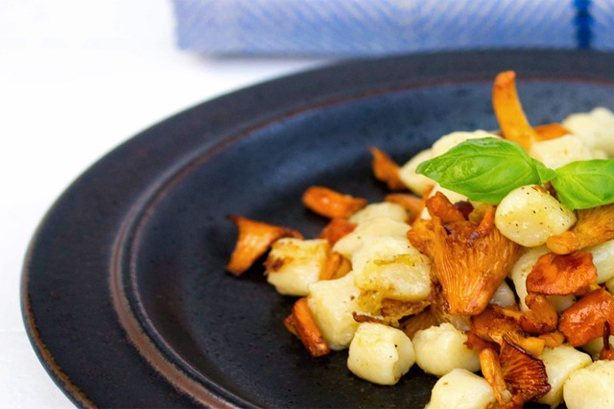
Ingredients
600 g organic potatoes (about 8 mid-sized raw potatoes)
180 g flour
1 tsk saltAlt.
1 Sautéd chanterelles
500 g fresh chanterelles
3 garlic cloves
1 handful basil leaves (about 30)
3-4 tbsp olive oil or butter
1 ml freshly ground black pepper
sea salt
parmesan (for non-vegans)
Alt. 2 Asparagus and tomato
1 bunch of asparagus (about 12)
3 garlic cloves
3-4 tbsp olive oil
12 baby tomatoes, halved
30 g arugula
1 ml freshly ground black pepper
sea salt
parmesan (for non-vegans)
Method :- Serving: 3-4 People
- Step1: For this recipe you’ll need a potato press, scales and preferably a food processor.
- Step 2: Weigh the potatoes, then put them in a pot with water.
- Step 3: The water should only just cover the potatoes.
- Step 4: Bring to a boil, and let the potatoes cook until soft – about 10-15 minutes if they are new potatoes, otherwise 15-20 minutes.
- Step 5: Peel and press the potatoes.
- Step 6: Weigh and add the flour, along with the salt.
- Step 7: Mix the ingredients in the food processor for a moment – just enough for the potatoes and flour to come together.
- Step 8: Press the crumbs into a dough and place it in the fridge to cool for a while.
- Step 9: The dough is easier to work with when it's cold, so if you have time you can leave it in the fridge for 30-60 minutes or more.
- Step 10: Lightly flour the tabletop or a pastry board.
- Step 11: Divide the dough into six equal parts, and roll them into sausages about the thickness of a finger.
- Step 12: Roll them in flour so they don’t stick together.
- Step 13: Place them parallel to each other and cut them into pieces, about 2 cm wide, using a sharp and floured knife.
- Step 14: Bring a good amount of lightly salted water to boil in a large pot.
- Step 15: Put the gnocchi in the boiling water, about 20 at a time.
- Step 16: When they are done, after about a minute, they will float to the surface.
- Step 17: Fish them out with a slotted spoon and place them in a bowl with cold water.
- Step 18: When they’re all done, pour away the cold water using a colander, and pour a bit of olive oil over.
- Step 19: Keep the gnocchi in the fridge, for now.
- Sautéd chanterelles:
- Cut the fresh chanterelles in fairly large pieces – the smaller chanterelles don’t need to be cut.
- Chop the basil leaves and peel the garlic.
- Fry the chanterelles in a frying pan on medium-high heat until the water boils away.
- Then, add oil (and a bit of butter, if you want).
- Raise the heat and add the gnocchi and crushed garlic.
- Sauté the gnocchi and the chanterelles until they’re golden.
- Remember to keep stirring, because the gnocchi easily stick to the pan.
- Add basil leaves, as well as salt and pepper to taste.
- Top it all off with some freshly grated parmesan.
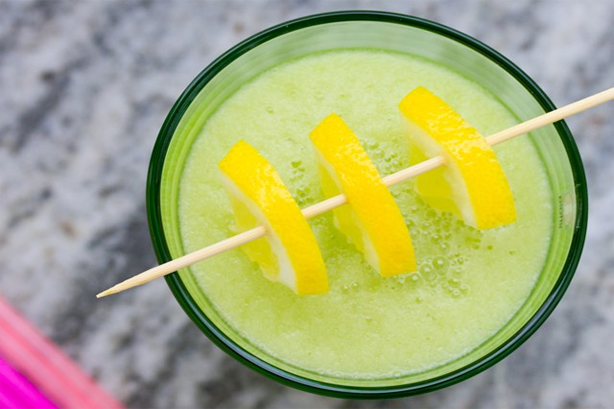
Ingredients
10 cm peeled cucumber (ca. 5 oz/140 g)
½ peeled green apple
1 celery stick
50 ml water
1 tsp lemon juice
1 tsp agave syrup
2 ice cubes
Method :
- 1 Glass
- Step 1: Peel the cucumber and the apple and put in a blender.
- Step 2: Rinse the celery, divide in a couple of pieces and put in the blender (the leaves too!).
- Step 3: Add water, lemon juice, agave syrup and ice cubes.
- Step 4: Blend into a smooth drink.
- Light and refreshing drink, suitable a hot day.

Ingredients
½ head of cauliflower
1 small yellow onion
½ zucchini
3-4 tbsp oil
3 lime leaves
1 tsp green curry paste
400 ml crushed tomatoes
400 ml coconut milk
200 ml red lentils
200 ml water
1 tsp salt
1 cup Capsicum, chopped
Method :- Serveing : 5-6 people
- Step1:Peel and chop the onion.
- Step 2: Rinse and take the cauliflower apart, into little bunches.
- Step 3: Rinse and slice the zucchini.
- Step 4: Mix the curry paste with a little warm oil, then sauté the vegetables and lime leaves with the oil and curry paste.
- Step 5: Cover the pan and let the ingredients soften slightly.
- Step 6: Add crushed tomatoes, coconut milk, red lentils and water.
- Step 7: Let it simmer for a long time – the longer you leave it, the more the flavors will come out!
- Step 8: The stew should simmer for at least 20 minutes. Add salt to taste.
- Step 9: Serve with arugula salad !!!
- The coconut milk gives this dish a smooth and sweet flavor, and the green curry paste and lime leaves gives it character.

Despite their short bloom time and unattractive foliage after the blooms are gone, they are still a wonderful addition to any landscape. But how should you care for them? First let’s talk about how to use them in your landscape. Flowers of all kinds are best when planted in groupings. Many people buy 25 or 50 bulbs and just go around the yard planting helter skelter. That’s fine if that’s what you want, but when planted that way they tend to blend in with the landscape and really don’t show up well at all. When you plant them in large groups they are a breathtaking showpiece.
In the early spring start thinking about where you would like to create a bed for flower bulbs. Prepare the bed by raising it with good rich topsoil, and if at all possible add some well composted cow manure. Do this in the spring while you are in the gardening mood, you may not be in the fall. Over the summer fill the bed with annual flowers to keep the weeds down, and to pretty up your yard for the summer. Come fall all you have to do is pull out the annuals and plant your bulbs to the depth recommended on the package.
When the bulbs come up in the spring and start blooming, you should clip off the blooms as they start to wither. This keeps the bulb from producing seeds, which requires a lot of energy, and you want the bulb to use all of its available energy to store food in preparation of the bulb’s resting period. Once the bulbs are completely done blooming you don’t want to cut off the tops until they are withered and die back.
The million dollar question is how to treat the tops until that happens.
Many people bend them over and slip a rubber band over them, or in the case of bulbs like Daffodils tie them with one of the long leaves. This seems to work because it is a very common practice among many experienced gardeners.
Another thing which you can do is clip the blooms off once they are spent, and just leave the tops alone until they are yellow and wilted. If they are still not wilted when it’s time to plant your annual flowers, just plant the annuals in between the bulbs. As the bulbs die back the annuals tend to grow and conceal them. If one shows through you clip it off. I am sure this will work well for you.
]]>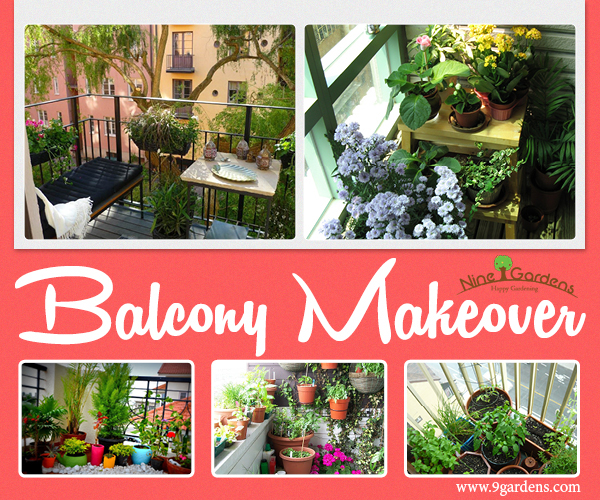
Your balcony can be decked up in a theme of your choice, be it flowers, succulents, herbs, hanging plants or a combination of all.
A Succulent Medley can be the best for the "Novice Gardener." Succulents are hardy plants and lend themselves well to container gardening. The reason you can chose to feature them are that they are almost care-free, need little water, lots of sunlight – and little else! They are a good start for a novice gardener, and you can see really quick results with them. And most visitors will love them. They make lovely pieces for table garden arrangements, or to simply decorate your balcony. One of such kind is Nephthytis: Nephthytis is very hardy, and survives well in the sun, even though it’s usually kept as an indoor plant, so it’s fine to keep it with the succulents. As the plant grows, you may have to trim it a little bit, to retain the look of the container.
You need not water succulents very often, and in fact, they lend themselves well to even containers that do not have drainage (although drainage holes are always preferred, you can even plant succulents in chipped ceramic mugs, or little bowls). If there is no drainage, just spray the succulents occasionally with water, don’t pour the water in. In Bangalore, succulents always prefer direct sunlight, and the more they are in the sun, the better the color is. Well-drained soil, and just the right amount of water also prevent rotting of the roots (though this is rare), and mealy bugs/ fungus.
The colorful and sweet-smelling range of flowers always put a vibrant effect to your gardening space and it’s specially a class when it comes to balcony gardening. Jasmine is lovely white and sweet smelling flower which gives us a lot of happiness. The moment you'll open the balcony door, you can smell its fragrance. If you mix Coco peat and compost and then plant your jasmine it so improves water drainage.Allamanda is the creeper plant. This plant grows very well, creepers traveling all over the net, rolling around the grills and rods of the fence, and fresh leaves and buds coming up. Roses can be arranged in the pots around the balcony but it gets dry easily so needs to water twice a day. Bougainvillea is another plant which adds colour to your collection with its beautiful arrangement of flower bunches in and around the stems.
You can add a flavorful touch to your balcony with herbs like Rosemary, Chives, lemongrass or any variety of herbs which can be used in the kitchen as well as which helps keep mosquitoes and other pests away.
After you are done with the placing of plants at seemingly appropriate locations you can add on to the beauty with black, white or coloured pebbles strewn on the ground or in the pots and by adding a water feature in one corner.Last but not the least, it is time to add chairs in the balcony so that you can enjoy the beauty of the newly done space.
Now you may wonder on how you have utilized the little space and made it to the most desired and sought after space for all the members of the house and the visitors!
]]>
Some herbs are also known to posses medicinal properties. Besides adding glory to your garden, herbs make your meals taste better. But once you start with a herb garden, maintaining it is equally important.
First of all, you need to fence your herb garden, if you don't want your herbs to be eaten by the four-legged creatures that make their way into your garden and slurp all the produce.
You have to ensure that your herb garden gets enough sunlight. 4-5 hours of daily sunlight is essential for the plants. So , make sure that your plants get a proper amount of sunlight daily.
You can fertilize the garden soil and enrich it with all the essential nutrients using your kitchen waste. Fruit-cores, vegetable peels, coffee grounds make for good fertilizers.Make sure to use natural bio growth boosters rather than chemical potions.
To keep away the garden insects from the herbs, spray soapy water on the undersides of the leaves. Weeding regularly is also important to eliminate competitors and ensure maximum growth. Make sure you weed the garden at regular intervals so that the task does not seem burdensome.
Remove dead herbs, leaves and dry twigs to maintain the beauty of your garden. Also, remember to water the herbs regularly to keep them hydrated. If you wish to use the herbs in your kitchen -pinch the plants regularly. Yes, pinching the plants makes them fuller and bushier. Herbs like basil do well after being pinched. You can watch and rejoice over the results you get ,after pruning.
As they say, "A happy garden for a happier you." Keeping your garden happy and healthy would provide you a feeling like no other. It would serve you with the daily dose of physical exercise and provide you a peaceful mind. So just, bring out the gardener in you and garden on..
]]>
Ingredients
10 to 15 Indian Gooseberry (amla), grated
1 tbsp oil
1 tsp mustard seeds
1/2 tsp asafoetida
1 tsp turmeric powder
3 to 4 green chillies, chopped (or less)
1 tsp fenugreek seeds, lightly roasted and ground
2 tsp salt or to taste Method :- Step1: Lightly roast the fenugreek seeds in a heavy bottomed iron skillet or wok. Crush to a powder with a mortar and pestle.
- Step 2: Heat the oil in a wok over a medium flame and put in the mustard seeds. When they pop lower the flame and add the asafoetida, turmeric powder, greenchilies and fenugreek in quick succession.
- Step 3: Turn off the heat after 30 seconds or else the turmeric will go black and the fenugreek seeds will turn bitte
- Step 4:Stir in the grated amla and salt.
- Step 5: Allow to cool, put in an air tight container and store in the refrigerator for up to a month
Are you tired of the dull look your garden possesses? Are you ready to add a little something to your garden that would make it capture hearts? Then, you are at the right place. In this article, we provide you with some of the tips and ideas that can help you give a perfect look to your garden and turn it into a wonder your neighbours would envy and wish to possess.
Many a times, we just ignore the paltry things that help in achieving an aesthetic garden. Things like the right garden design, the perfect lamps, the exquisite garden furniture, beautiful flowers, little ponds etc. just spice up your garden, filling it with beauty and liveliness. Designing your garden is fun, rewarding and stress relieving. Bringing together random things, a bit of outdoor space management and being experimental and a little creative are just the right ingredients to a perfect garden.

The Garden design
The right garden design is pivotal to a perfect garden. It involves capturing a beautiful landscape into a small garden with just the right practicability. You need to consider the whole area and then determine the things you would want to have in your garden. You can formulate a plan for the whole garden and then work on it.
You also need to decide the use of the garden: whether it is a place for you to sit and relax, place for inviting friends and relatives for dinner, a space for a summer soiree or an area for growing veggies to take care of your meals? This will help you determine the must haves for the garden. Decide the things that you will like in your garden. A path will help you in walking in the garden and admire it. A perfect path not only allows quick access to the house, but also adds beauty and character to your garden. Cut flagstone, old and recycled bricks can be used as a paving material for the path. A path 4-5 foot wide can serve well for a garden.
The garden furniture
A perfect garden should provide you with a comfy place where you can sit back and relax after your back-breaking office routine. It should be stylish, comfortable and elegant. You need to decide the size, color, shape and material of the garden furniture. The style of the garden furniture is equally important. Besides comfort, material and size of the furniture, the style of the furniture is to be considered as well. Choose a style for your furniture that goes with the general style of the garden and your home. Using bamboo for the garden furniture can instantly make your garden look beautiful. It is easier to maintain and eco-friendly too.
When it comes to having a perfect garden, you also need to think about the pots, nearby objects and other things, besides the foliage. Try placing planters in your garden near a water source, so that you can avoid running all over the space to fetch water for your plants. You can plant in stylish containers that match the whole look of the garden. Ferns, strawflower, English ivy, lantana look gorgeous in planters. Planting in hanging baskets add charm to the garden. Planted pots look beautiful when put along the garden path. You can also put the planters around a swimming pool or a pond in your garden. You can plant a combination of flowering plants in a single large pot and place in on a pedestal. Trees too, work wonders for your garden. Planting ornamental trees like Japanese maple, white cedar, Crabapple, redbud, willow oak provides you with a beautiful garden you can proudly stroll in. They provide shade and add colors to your garden.
Other things like exquisite lamps, fountains, bird houses etc. provide extra charm and beauty to the garden. You can add these things to set the right mood and bring liveliness to your garden.
So, bring out the designer in you. Experiment and try different things to get the perfect look. Go sit in your garden when it’s done, and savor the taste of nature.
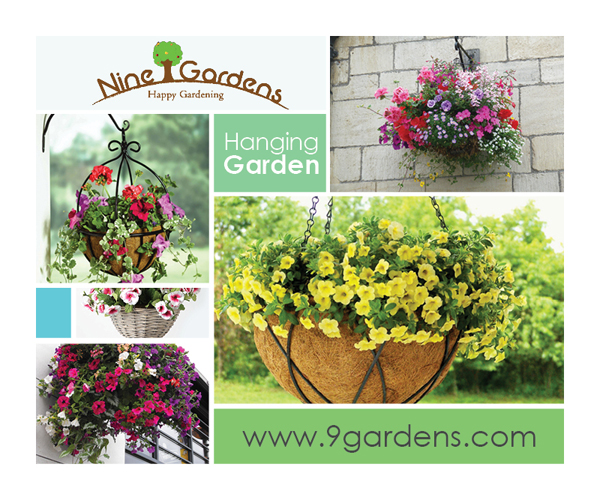
The portability of such a garden is more and there are far lesser chances of weeds giving competition to your plants. If you wish to use the "hanging garden" for decorative purposes you can grow plants like pansies, alyssum, impatiens. They will add much to the beauty of your balcony. Herbs like oregano, savoury, basil, thyme are wonderful choices for such a garden. Almost every herb grows well in baskets .They add to the greenery and can be used for flavouring you daily meals. Beans, lettuce, cucumbers, tomatoes, peas can be grown easily in baskets. Trailing plants like ivy, verbena, sweet potato etc. hide the basket and provide it a fuller look. They are very colorful and extremely beautiful to look at.
The first question is about the choice of container to be used. You can go for a plastic or a wire basket. Wire baskets look beautiful and work the best. You need to line the basket with moss or coir fiber but remember to soak the liner before you start with the planting .After soaking , fill the basket with the soil and start planting. Choose compact and short plants to grow in baskets. Make sure that the structure of the pot used is capable of handling the weight of the soil and the plant. Almost all plants require sunlight. Do ensure that your plant receives at least 4-5 hours of sunlight daily.
You can fertilize the soil with manure and kitchen waste to retain the nutrients in the soil. Watering the plants is equally important. Baskets that are hung one above the other can be watered very easily. Just water the top most basket and allow water to drip into the basket below and so on. All the plants in the baskets can be watered using this technique. The potted plants require more water as compared to those on the ground. Therefore ,you need to keep the plants hydrated. Hanging pots or baskets can help you eliminate the need of large yards for gardening. It's like a mini garden in your balcony. So, if you are frustrated with the lack of space in your apartment, do not let it stop you from having a beautiful garden meeting your food requirements.
]]>

It serves various advantages over the traditional methods of gardening .The yield is more and the growth process is speedier. It eliminates the problem of soil erosion, since no use of soil is involved. The nutrient solution is easily recycled and thus, the quantity of water used is much lesser. The nutrients are easily absorbed which ensures higher yield and productivity. Higher supply of oxygen ensures effective root system and happier plants. It enables faster growth and therefore, hydroponic plants can provide fruits much before the soil plants. Almost all terrestrial plants can be grown by the method of hydroponics. This method can effectively eliminate the problems of bug intrusion and weeding. "The hanging gardens of Babylon" built by Nebuchadnezzar which was once included in the "eight wonders of the world" provides an excellent example of hydroponics in the past.
The major nutrients required by a plant are potassium, nitrogen and phosphorus. An adequate amount of each nutrient in the solution is required to effectively implement the technique of hydroponics. There are two major types of techniques of hydroponics : Solution culture and Medium culture.
Solution culture requires only the nutrient solution for growth while medium culture on the other hand requires the solid medium for the plant growth. The ph of the solution is required to be perfectly suited to the needs of the plant. A ph of 6.3 is however considered optimal. Choice of an appropriate growth medium is necessary before you try hydroponics which would mostly depend on the growth techniques used. Various growth mediums like clay pebbles, rice hulls, sand , gravel, pumice are available.
Hydroponics is a type of indoor gardening. Therefore ,replicating the outside conditions by matching the temperature and humidity levels is required . The technique proves to be costly as the start up cost of going hydroponic is normally high. Also, the hydroponics grow lights which are used to provide proper light to the plants are expensive. A detailed plan and proper skill set is required before you step into such a venture. With increasing needs for land , a technique like hydroponics can serve pretty well.
]]>
With the growing lack of space for gardens in cities and towns, terrace farming would help you answer the limitations.
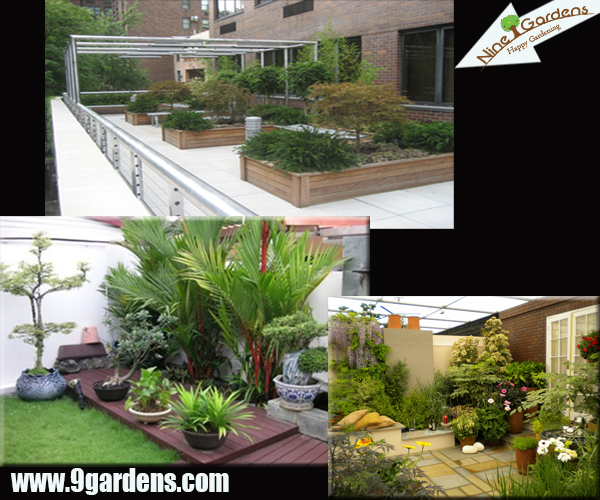
You will have to carefully choose the plants to be grown in your terrace to have a perfect garden . The plants chosen must not be of the tap root system as they can pose a structural damage to your building. Thus, the plants with shallow roots/fiber roots would just be perfect. Plants which require lesser quantities of water should be preferred because those requiring lager amounts of water would only weaken the roof structure. A proper drainage system is essential to avoid any potential damage to the building.
Try creating raised soil beds to grow vegetables, herbs or even flower plants or make use of pots and planters.
Medicinal plants like Aloe Vera , Bryophyllum, Tulsi etc. and Vegetable plants like chillies, ladyfingers ,tomatoes etc. can be easily grown in the terraces . Mint , basil, chives, cherry tomatoes ,angelica are herbs which are required almost daily by the households and can be picked straight from your terrace if you plant them. If your terrace lacks sufficient space, you can grow plants in pots and make steps to accommodate them. You can also grow carrots, radish, turnips or even cabbage, cauliflower or broccoli in raised beds or planters with a depth and width of 30cms x30cms or more.
After starting with a terrace garden, tending the garden is equally important. Taking care of the garden is of utmost importance when one starts his/her own garden. Watering and turning the soil regularly will keep your plants happy and provide them strength. Remove dry twigs and leaves regularly to keep the garden beautiful. Use organic methods of farming to reap maximum benefits.
Terrace gardening provides a number of benefits. Besides lending an aesthetic appeal to your terraces, it also provides you with fresh and healthy food. There is a considerable difference between the quality and taste of the food produced in your own garden and what is bought from the market, the former obviously being better. Terrace gardens claim to keep your homes cool as the mercury rises. Everyday kitchen waste can be put to use as a fertilizer in the terrace garden easily. Apartments and buildings which lack proper space can have beautiful gardens with the help of terrace gardening. Terrace gardening also provides benefits in terms of physical activities it involves, which keeps the body moving. So, if it is the space problem that keeps you from giving a green signal to your green thumbs, start with a terrace garden today. Abandon those boring terraces and bring home the amazing idea of terrace gardening.
So, start with a terrace garden and make your neighbors envious of one.
]]>Gardening is always fun and when combined with cooking, it is a different experience altogether. How often did you have to run to the vegetable market to get one or two vegetable ingredients of your favorite dish? You must have also dropped the idea of preparing something delicious many times…just because you did not have capsicums, coriander or chillies. Now who would go to the market just to get one or two ingredients. The food prepared using the garden produce is not only healthy and but also it rejoices your taste buds and you can be hundred percent sure of the quality of the food since the ingredients are picked straight from your garden . The sense of satisfaction associated with growing your own food is certainly indescribable. Therefore , getting down in your backyards and growing what you eat is not only desirable but also gratifying and fun.

Getting Started
To start with a kitchen garden, the first thing you need is a small patch of land .You do not have to have a very large garden for producing food for your family . Begin with a small sunny space in your house. A proper estimation of the family needs is required so that you do not end up wasting the food you produce. You can grow everyday use vegetables and the necessary herbs for catering to your family needs. Various herbs like oregano, sage, mints, basil, coriander, rosemary can be grown in the kitchen gardens. Tending to the garden 2-3 hours a week can produce enough food for the family and can help you in keeping your body moving. You can fertilize the soil by using composts that can easily be prepared at your home.
Growing Greens
Consumers all around the globe claim that the food produced with the help of organic farming is more delicious and nothing less than a treat to the taste buds. Organic farming involves minimal application of the artificial fertilizers and therefore saves on the cost of production too. The technique of organic farming can effectively be applied in the kitchen gardens. Kitchen waste can be utilized in place of market purchased fertilizers .Using manure instead of synthetic fertilizers is definitely more productive since there is a visible difference in the quality of a product produced organically. Not only does it taste better but also it is healthier for one's body. Therefore, going green is highly recommended when it comes to growing your own food.
It's The Nutrition Knocking At Your Door
Know what you eat…The food prepared in kitchen garden is fresh, nutritionally sound and chemical free. Besides saving on your monthly food expenditure, the food produced in kitchen gardens ensures that you eat fresh and healthy food. Reduction in stress level and anxiety is another benefit it serves. Gardening also helps in exercising and keeping you active. Not to ignore the sense of satisfaction your kitchen garden will provide. The garden produced food is invaluable because there is least contact with the synthetic fertilizers and pesticides. The benefits that a kitchen garden would provide are certainly many and it simply tastes much better.
Hence, cooking is fun and a lot more advantageous when the ingredients are available in your garden. Choose a place in your house and start gardening for a healthier life and mental peace.
So just grab your spade and garden on....
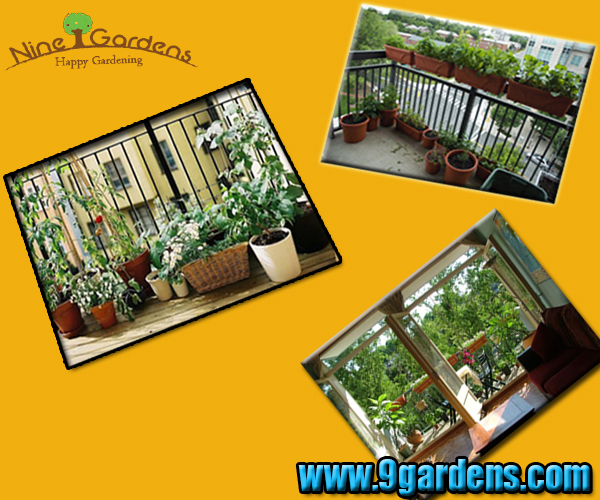
The first thing you will need to figure out is how much space you have. Living in an apartment means having limited space, but several plant containers can be placed on the fire escape (abiding by all safety regulations of course), handrails, and on the balcony. Boxed plants on the windowsill are also a good option. Make sure the plants will not get in your way or cause tripping and falling, and make sure the plants do not block any fire exits.
The next thing you need to know is how much sunlight your apartment gets. This is crucial, as certain plants need more amounts of sunlight than others, and this will determine what kinds of plants you get to grow. Tomatoes and cucumbers usually need full sunlight throughout the day, so be sure to place these in an area that gets direct sunlight. Your balcony may be an appropriate place for these veggies. Many herbs, particularly peppermint, oregano and thyme are plants that do not require a lot of light, so consider these if your apartment doesn’t get much light. If you are worried about not getting enough sun for your plants, indoor lighting is always an option.
Another important thing to consider with apartment gardening is what kinds of plants you want to surround yourself with. If you are someone that loves to cook, herbs and vegetables can become useful additions to your pantry. If you like keeping flowers and other non-edible plants for the aesthetic appeal, violets, hibiscus, lilies, jasmine, geraniums, poinsettias and orchids are all popular choices because they are generally low maintenance and grow well indoors.
Apartment gardens do require a lot of maintenance, but they are a nice addition to a small living space and can even help improve a person’s mood. They will also improve the air quality. Spider plants, lilies, Chinese evergreens, philodendrons, and snake plants among others, are considered to be the most effective plants for treating indoor air pollution. Having plants in your home also creates a unique fragrance. Who needs potpourri? Your friends will come to associate these scents with you every time they catch a whiff of jasmine or hibiscus, or rosemary or thyme.
Your apartment garden can be as big or small as you want it to be, whether it be a few plants on the windowsill, or a full garden, it’s up to you.
Enjoy it, make it last, and show it off!
]]>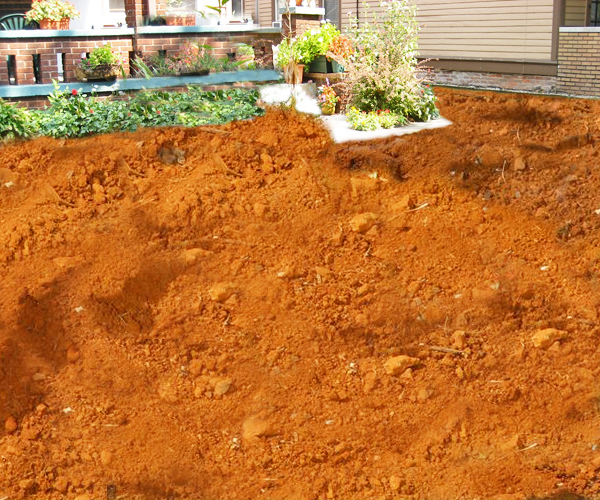
Gardening is a concept which didn’t grow its stem in a single day rather it took time to establish its fundamentals in the society. Man first started to grow crops for eating, but as it became easier to grow plants, an interest arose in growing plants to improve his surroundings. As time went on, gardening became a status symbol. No longer was seed just thrown down, it was placed in arrangements to show one's power, wealth, and skill. All of the great palaces of the world had gardens, making it one of the most universal forms of art in the world. It was not uncommon to see great areas of the courtyard filled with gardens, often requiring a large amount of water and work to upkeep.
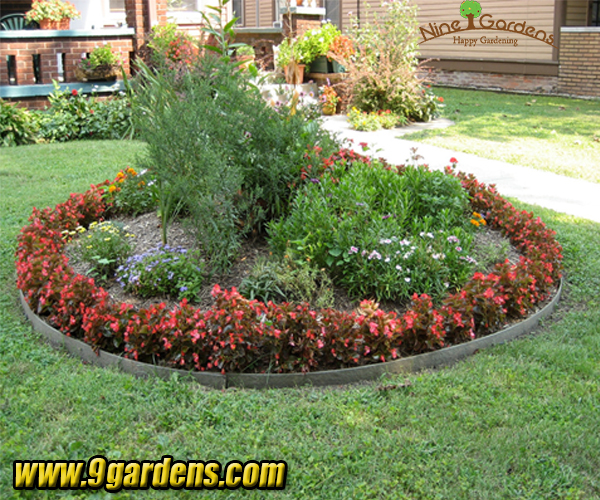
In today's world, gardens are for pleasure, not as a display of wealth and prestige. It’s a joy to see a beautiful garden in front of your house instead of an atrocious barren stretch of land. The art of gardening has evolved through the ages. Even the simplest gardens are great works of art. They combine color, composition, texture and creativity and have provided beauty and pleasure for centuries. And designs come from all over the globe. European gardens have their roots in Rome, but grew because of the Byzantine Empire. Modern day gardens are varied and incorporate many of the influences that have existed throughout history. Today's gardeners create everything from traditional English gardens to practical vegetable gardens to Japanese Zen gardens.
Gardening has now taken its form in arts. It is more often considered to be a skill. Any person who is creative and imaginative and has a deep love for nature can definitely engage in gardening activity.
Over a span of time gardening also became popular due to its over the range of advantages. We all know that gardening keeps us green which in turn keeps us cool. But the other aspect of it , is that it helps us to be healthy. Yes! You guessed it right if you think that by planting green vegetables we do include a healthy diet in our family food chart. But more than that gardening helps people to shed some amount of weight too. Those who spend their free time pruning the roses or pottering in the veggie patch are considerably thinner and fitter than their non-gardening neighbours. Green-fingered people are known to be healthy, energetic and full of life, as gardening helps to relieve them from everyday stress and fills them with radiance. Previous studies have credited gardening with a host of benefits, from raising zest for life to boosting happiness. In the latest study, gardening is regarded as a boon for the abolishment of obesity which has plunged so many souls into unwanted depression.
Gardening , a physical activity which unveils the treasure of beauty and grandeur of any land is nothing but a deed done to invigorate oneself and the surrounding .Thus proving itself as one of the rarest invention and evolution!
]]>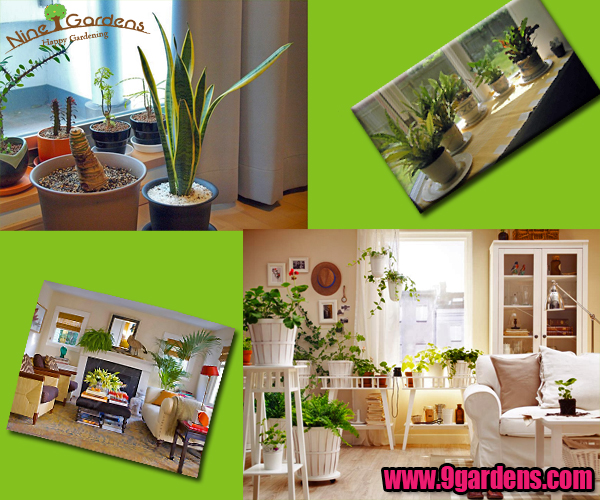
Image Source: gardenguides.com, interiorjapan.asia
To know about these plants, you don't have to be an environmental psychologist. Just dig a little deeper beneath their beauty and you'll discover the facts - the benefits of indoor plants go far beyond the aesthetic.
Indoor plants significantly improve a whole range of aspects of our indoor environment. The benefits cover a spectrum from physically cleaner air to direct beneficial effects on psychological health, task performance, illness reduction and productivity. In urban areas where we spend an amazing span of our time indoors, the quality of the indoor environment is crucial to our wellbeing. Many people do not know that air pollution is almost always higher indoors than outside, and these plants help improve air quality inside our home. These plants can also be effective at reducing background noise. Although plant selection and positioning are crucial to achieve these effects. Indigenous indoor plants like begonia, some species of balsam, ficus, and indoor species of cycus can be grown as they suit the environment and add to freshness. There are not many indigenous indoor plants as we never had a tradition of growing plants inside home. There is a need to work on Indian plants that can be used for indoor decoration.
Generally, summer is a slack season for sale of fruit, vegetable seedlings, pots, fertilizers but the business of indoor ornamental plants has gone up remarkably, which shows that people have gradually started taking such factors into consideration for the welfare and enrichment of their homes and its environment. And this is a very positive indication that we are moving towards a healthy and prosperous India.
]]>
Summer is for flowers, whether it’s beds of colour co-ordinated perennials, multi-coloured eruptions of bedding plants from hanging baskets and containers, or the queen of summer shrubs – the rose. Hibiscus, Zinnia, Periwinkle, Carnation etc. are some flowers which fall under this category. As we head into summer, it’s time to take a critical look at your garden and decide how you’re going to prepare it for the coming heat. Though plants, trees and lawns seem to take care of themselves, they need tending even through midsummer's period of bountiful growth. It becomes a challenge for you to keep your plants and flowers looking their best and enjoying what you've grown.
May is the month to plant annuals, warm-season crops that grow best in higher temperatures with deeper root systems. They also need to be watered and fertilized often as higher temperatures lead to faster evaporation. They include traditional summer crops such as snap beans, corn, cucumbers, melons, peppers, tomatoes, and squash .Tomato is considered "easy to grow," meaning that they grow well in our climate and don't need fussing over every day. But that doesn't mean they can be ignored after they've been planted. They need to be checked once in a week ( at least when planted)making sure they are insect-free and that leaves are healthy, while removing dead or rotting ones, weeds need to be withered out. It's tempting to ignore vegetables until harvest season, but consider that you'll get much better yields if you stay on top of problems.
Watering your plants becomes the most vital step in maintaining your garden in summers. Don’t forget, though, that every plant needs to be given supplementary water in its first few weeks and when its summers, it becomes all the more important for almost all plants.
Self-watering containers have proved to be a boon for all busy people who takes gardening as a hobby but is too packed in their schedule to propagate it in a scheduled manner. These containers give a bit of a cushion when you aren't home to water every day. Remember, in most cases, the bigger the better.
To water tomato plant or for that matter any summer crop, you might try bottle irrigation method. Try to plant a bottle with holes next to your tomato plant roots, place the cap tightly after filling it with water. It will continuously water your tomato plant without a fail till you refill it. Its a very effective method for the first two weeks after you place a tomato plant in your garden.
For those who are too lazy to adopt new methods to keep their plants healthy in the scorching heat of summers, try to give your garden a new look with succulents, which have evolved to store water, are renowned for their drought hardiness, which is available in wide range these days. And there are many of the fashionable structural plants – those that are grown for their shape and the dramatic effect of their leaves rather than their flowers – require minimal extra watering. Lomandras, cycads, yuccas and bird of paradise are some suggestions. The simplest and evergreen method to give flourishing effect to your garden always remains to be the sustainable practice of the “right plant in the right place."
So don’t let this season fade away before you show some of your brilliant creations in your garden to the Mother Nature!
]]>

The cilantro is a very popular herb in the Indian cuisines and frequently used in curries, salads and soups. Also known as coriander or dhania patta , it has health benefits such as promoting healthy liver function and offering relief from stomach indigestion. Its anti-inflammatory properties can also help to tackle the symptoms of arthritis. This uniquely aromatic herb can be easily grown in your kitchen garden, and you better make sure that it is a persistent feature in your meals.
The curry leaves are also one of the most commonly used herbs in Indian households, particularly in south India. Employed in making of dals,rasams, sambhar and chutneys, these leaves are useful in preventing nausea and indigestion. They have also been known to improve eyesight and beneficial for hair growth. So the next time you think of separating the curry leaf from your food or throwing it away, be wary that you are losing out on a chance to improve upon your health.
The mint or pudina is a herb with a beautiful appearance and a long shelf life when stored in a sealed container. Its typical aroma is derived from menthol, its chief ingredient. It is used in as teas, beverages, jellies, syrups, candies, and ice creams .Amongst the Indian cuisines, you can easily observe the flavor of mint in Hyderabadi Biryani and the paani of paani poori. It is a perennial plant which you can grow in partial shade as well as full sunlight. It is a herb which you can use for both for flavor and garnish. Its health benefits include curing of stomach aches, removal of bad breath and whitening of teeth.
The rosemary is another perennial herb with a strong fragrance used in fruit salads, vegetable platters, soups and meat dishes with lambs in particular. It is a woody herb with needle-like leaves and requires a sunny and well-drained space to grow. It should always be kept moist and you can grow it even in a container. The consumption of rosemary is a natural way to deal with migraine and boost immunity.
Some of the other culinary herbs used frequently in dishes are basil(tulsi), thyme, parsley, oregano, sage, chives and dill. Thus it is quite evident that these herbs have the ability to transform ordinary food into ambrosia when used in appropriate amounts to make the right dishes. The experience of eating is given a whole new dimension after the addition of these wonderful ingredients. If you thought that they were an overrated part of the whole cooking process, you better think again!
]]>It is often said that water is life. And this saying is perfectly applicable for plants, which consist of around 90% water. So how you go about watering your plants will be vital in determining the overall appearance of your garden. It is true that lack of proper water supply causes the plants to wither and die, but you should be cautious enough to prevent flooding too.
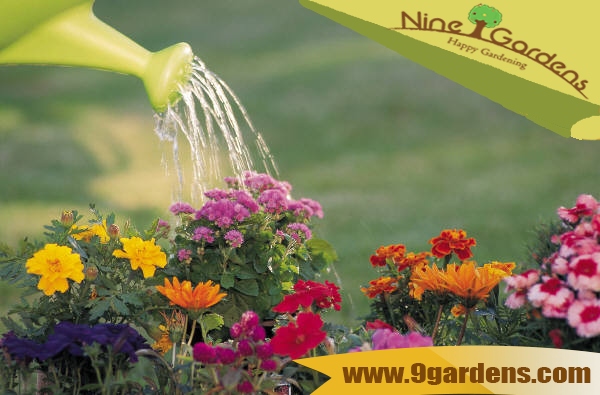
Each year, several individuals take up gardening, spending large amounts of money in the planning and planting of their dream garden. Yet, within a year, the once beautifully laid out garden begins to resemble a vegetal graveyard.
There are myriad factors that need to be taken into account when it comes to watering your plants. As you need to ensure minimum evaporation, the most congenial time to water the plants is in the morning or evening. But one precaution to be taken during evening time is not to wet foliage, as it makes the plants prone to diseases by making them vulnerable to the growth of fungus or mildew. Avoid excessive watering as it reduces the supply of oxygen to the roots which is damaging to the plants. You can use a soil probe, which is a metal rod with a pointed end, to determine the depth to which water has reached. When the dry part of soil is reached, you will find it harder to penetrate further.
Different types of plants have different water requirements. Plants which require more water should not be placed adjacent to the plants that need less water. Keep the hydrophilic plants such as marsh marigolds and cardinal flower in the moist areas of the garden or where you can supply water more easily. The plants of arid climates such as cactus can be placed in the drier parts of your garden. Also young plants need to be watered more frequently compared to the older plants so that their roots become settled. After a couple of years, you may reduce the watering frequency as the plants mature.
The type of soil also dictates the amount of watering required. Water retention is more efficient in clayey soils than sandy soils. So you should provide more watering at a faster pace in case of the latter and less watering at a slower pace in case of the former. Erosion results if you provide water quickly in clayey soils as run-off occurs. Mulching is generally done to reduce run-off and minimize evaporation.
You should also take weather into account while deciding the water needs of the plants. In hot and dry months of summers, evaporation is rapid and thus more water is required by plants. In winters, evaporation is less and if there is rainfall at that time, it reduces the water requirements significantly. Similarly, in the time of monsoon, there is high humidity and rainfall, thus minimizing the additional water needs of plants. You can use a rain gauge to measure the amount of rainfall and thus estimate the supplementary water needs.
Finally, you may think that watering your plants is quite a complicated process incorporating many factors. Although you need to be a bit careful initially, but as you gain experience after a period of time, you will instinctively know how much water to be provided to a plant. Thus you will acquire this special ability to keep your garden looking green and refreshing all the time.
]]>So let out the creative soul in you.
Here is the guide to start creating the animated miniature garden-
Choose a pot in which you would like to grow your miniature garden-The broken pot will need to hold enough depth of soil in the base without danger of the soil washing out when the plant is watered. So it is essential that the pot has a 2.5-3 inches wall above the base.

Image Source: iamtrend.com, thefernandmossery.com
Clean the pot thoroughly and cover the hole at the bottom of the pot with a broken piece of terracotta.Dump in some gravel. This is for the drainage.Fill the pot with the soil, but remember to leave a couple of inches from the top.Use broken terracotta pieces as dividers for your miniature garden.

Start planting the largest things in your miniature garden first; to make sure you have room for the largest things in your garden. So, the tree goes first and then various succulents. Place miniature accessories to bring life to your garden, but make sure not to make your miniature garden over-crowded with objects.

Image Source: maxpark.com, sugarcreekgardens.com
Hope you have enjoyed the creativity!!
You mini garden is ready!!! And the best part is, you can move it to any place.
]]>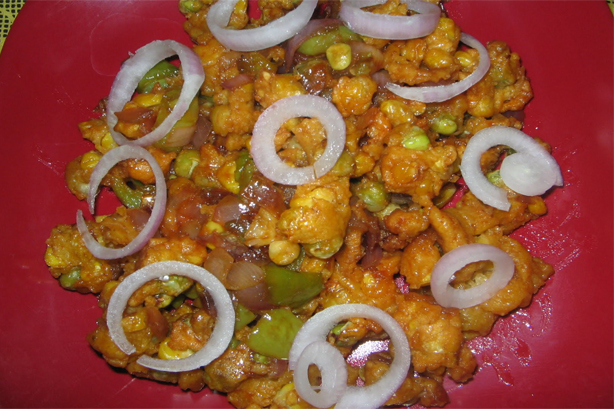 Ingredients
Ingredients
1 cup Capsicum, chopped
3 heads Baby Corn
1 cup Fresh Beans
2 Potatoes (medium sized)
3 Onions (medium sized)
1 Tomato (medium sized)
1 piece Ginger
5 Garlic Cloves
1 tsp Mustard Seeds
1 1/2 tsp Chili Powder
1 tsp Turmeric Powder
1 tsp Garam Masala Powder
1 tsp Cumin Seeds
15 Cashews
4 tsp Kasthuri Methi
Method :- Step1: Chop the baby corn into small pieces.
- Step 2: Wash the potatoes and peel them. Cut them into medium-sized pieces.
- Step 3: Add the chopped potato, baby corn and fresh beans to a bowl of salt water.
- Step 4: Cook this in a cooker for 15 minutes.
- Step 5: Peel the onions and chop them into tiny pieces.
- Step 6: Wash and chop tomatoes.
- Step 7: Peel the garlic cloves.
- Step 8: Add the chopped onions, tomatoes, ginger, garlic and cashews to a blender and blend until it becomes a smooth paste. Add water, if needed, in order to get the right consistency.
- Step 9: Take a pan and add 5 teaspoons of cooking oil to it. Once the oil is hot, add the chopped capsicum and fry for 2 minutes.
- Step 10: Transfer the capsicum to another bowl.
- Step 11: Add 1 teaspoon of oil to the same pan and heat the oil. Add mustard to the oil once it is heated.
- Step 12: Once the mustard stops sputtering, add chili powder, turmeric powder and garam masala powder to this and fry this well.
- Step 13: Add the previously blended mixture of chopped onions, garlic, etc to the pan and cook over a low flame.
- Step 14: Stir the mixture until the water in it evaporates and the gravy begins to get thick.
- Step 15: Add the vegetables that were cooked in the cooker and cook for 1 minute.
- Step 16: Add the fried capsicum and salt to taste.
- Step 17: Add kasthuri methi and cumin seeds. Stir for 2 minutes and take the pan off the heat.
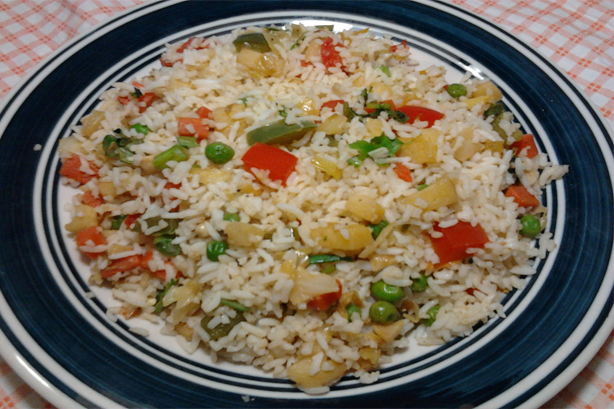
Ingredients
Cooking Time : 25 min
Yield : 4 servings
- butter or oil 2 tsp
- cabbage, shredded ½ cup
- capsicum, sliced 1 number
- curry leaves 1
- ginger and garlic paste 1/2tsp
- Green chillies chopped 2 number
- onion, chopped 1 small number
- pepper or chilli powder(with pepper is good) 1/2 tsp
- salt to taste
- uncooked rice 1 cup
- whole garam masala spices(optional) 1tsp
Preparation Method of make Capsicum And Cabbage Rice
- Step 1:Cook rice and set it aside to cool.
- Step 2: Heat oil in a kadai and fry spices and add onion ,salt,curry leaves, ginger and garlic paste for 2 to 3 mins till it turns goldenish pink.
- Step 3: Add cabbage and capsicum and cook for another 2 to 3 mins.
- Step 4: Add rice, pepper, and salt. Simmer for 2 to 3 mins.
- Step 5: Serve hot with Raita and pickles
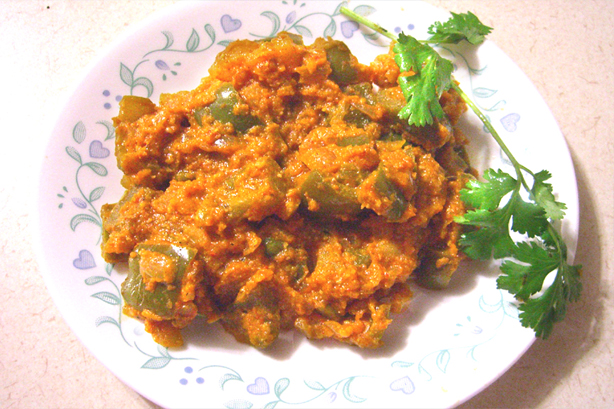
Ingredients
Servings 2 Adult(s)
- Capsicum(big) - 1 No.s
- (cut into small cubes)
- Onion(medium) - 1 No.s
- Tomato - 1 No.s
- Garlic pods - 5 - 6 nos
- Ginger - A little
- Cumin seeds(Jeerakam) - 1 tsp
- Cloves(Grambu)
- Bay leaves(Vazhana/Karuga ela)
- Oil - 4 - 5 tbsp
- Coriander seeds - 1 tsp
- Groundnuts (Nilakadala) - 1 1/2 tsp
- Cashew nuts - 1 tsp
- Salt - As reqd
- Lemon juice - 1 tsp
Method :
Preparation Method of Capsicum Masala - North Indian Style Recipe
- Step 1: Fry capsicum pieces in oil and keep it aside.
- Step 2: Fry coriander seeds, cashews and groundnuts separately, without adding oil.
- Step 3: Make a paste of groundnuts and cashews separately.
- Step 4:Grind onion, tomato, garlic, ginger, cumin seeds, the spices and coriander seeds into a smooth paste.
- Step 5: Heat oil in a frying pan.
- Step 6: Add the ground masala and fry, until the oil starts to separate.
- Step 7: Add groundnut paste and cashew paste.
- Step 8: Stir well and let it boil for about 3 mins.
- Step 9: Add fried capsicum and stir well.
- Step 10: Close with a lid and let it cook for 5 - 10 mins.
- Step 11: Add lemon juice to Capsicum masala, before removing from the flame.
- Step 12: Garnish Capsicum masala with coriander leaves before serving.
Serve Capsicum masala with chappathi, naan, fried rice etc.
]]>
Utilize the backyard space
A barely usable backyard can evolve into a cozy family retreat.
Well-defined spaces and meticulous attention to detail can make even a small corner seem spacious.
Build a concrete seat adjacent to the wall. The area must be amidst greenery. Plant flowers and wide range of ornamentals all around. This will serve as a wonderful place to relax.

Image Source: tenortile.ca, indulgy.com
Place a concrete or metal fire pit, which will add a touch of warmth to your rendezvous.
A container of low-maintenance succulents adds a playful pop of color and texture at the end of the bench.

Image Source: fiestafarms.ca
A pot of floating plants or flowering creepers and climbers can add to the scenic beauty of the place
Spread gravel on the ground around your bench and create a mulch to avoid unwanted weed and grass.
If you have enough space left, you can even set up a pool of water with fishes in it.

Image Source: popscreen.com, fr.123rf.com
Your atrocious backyard has now turned into an elegant and serene place to relax.
Hope this makeover would give your garden, the desired scenic beauty.
Happy Gardening!!
]]>

Apart from watering your garden, one must also fertilise, weed and tend to the plants’ various other needs. Any seed or gardening catalogue generally provides you with several options with which you may tend, fertilise and protect your garden from unwanted guests. Yet, what these items do may very well be done by common household products.
Pesticides- Aspirin, canola oil, chilli powder, rubbing alcohol, even tabasco sauce and liquid soap (not detergent) are effective pesticides and insect repellents. Baking soda and cinnamon powder may be used against fungal growth. Corn gluten meal inhibits the germination of weeds and white flour acts as a repellent to grasshoppers. All these items may be found at a local grocery store for the fraction of the price of organic pesticides.
Mulching- Newspaper, cardboard and leaves are three of the best things to use as mulch around your plants. Mulch holds in moisture and prevents the growth of weeds.
Fertilisation- Worms, also known as ‘soil engineers’ especially love the cardboard and will congregate near the surface and work their magic on your soil. Coffee grounds, cooking water and water from your fish tank are also excellent ways to nourish your soil. Cooking water retains the nutrients of the food cooked. One must be sure, however, to allow the water to cool before watering your plants. When you change the water in your fish tank, use that water because it's a natural source of nitrogen.
Growing creepers- climbers such as beans, peas and tomatoes or even decorative plants require a sort of ‘back bone’ on which to grow. Old broom handles, pieces of wire fence, scrap wood and even branches may be used for this purpose
Container Gardening- Rather than running out and investing in new pots, check your basement or attic for such things as old buckets, saucepans, colanders, plastic storage bins; even a child's outgrown plastic potty. All you have to do is drill a few holes in the bottom for drainage, and your container is ready. You can always decorate and disguise it with glitter and other such products – a new arts and crafts project to keep your child entertained.
These are but a few ways by which your garden may benefit from the products commonly found in your house. You may no longer use shortage of funds as an excuse not to start a garden. Begin planting today!
]]>The first five years are critical for the long-term health of a tree. Caring for a tree in these formative years are thus of extreme importance. While trees require more or less the same things as plants do, the proportion and type may vary significantly.
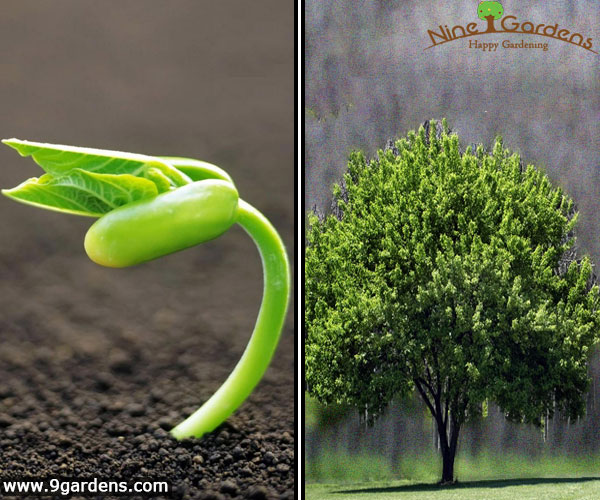
The first and most important step to take, while planting trees, would be to maintain some space between the two young trees so as to avoid congestion.
Young trees require regular watering for good health and disease prevention. It is thus important to look for signs of drought stress. Such signs include the yellowing of leaves, wilting and browning.
Lawn irrigation does not provide adequate irrigation for trees. As, such forms of irrigation only penetrate a few inches of soil thus encouraging surface roots.Deep watering prevents surface roots from forming. 4-6 inches of soil must be moist (not wet) in order to ensure that the tree gets an adequate amount of water.
One may conserve moisture by undertaking the process of mulching. Cover the soil with a 2–3 inches layer of mulch extending 1–2 feet from the tree. One must also weed the surrounding landscape regularly so as to ensure that the tree does not have to compete with other plant life for water and nutrients. While it is important to weed, however, one must be careful not to prune the leaves and branches of young trees, especially in the first two years of development.
Young trees require a steady supply of water and nutrients. It is not prudent to tie the developing young trees too tightly with cords or wires. Cuts in the bark interrupt transport of water and nutrients and expose the tree to infection by pests and diseases. Protect trees from lawn equipment like weed whackers and mowers.
It is important to maintain the nutrient level of the soil in which the tree is planted. One must ensure, however, that one uses organic fertiliser or even compost. Chemical fertilisers, pesticides and herbicides can burn or damage a young tree’s roots and leaves.
Keeping these tips in mind, one may successfully grow a healthy tree. Though growing plants and growing trees are vastly different, they each provide the gardener bountiful rewards. When one gets flustered, therefore, when trying to maintain the perfect garden, it may do well to remember to ‘keep calm and garden on’.
]]>
Image Source: typepad.com, flickr.com and instructables.com
A rather simple way of planning and forming a hanging garden is by using hanging baskets. These may be either store bought or homemade. One must be careful in one’s selection of baskets. A wide variety of baskets are available in the market, including metal and plastic ones. Whatever your choice, be sure that they are neither too big nor too small in size. Further, one must be sure to add a fair amount of compost as well as moisture retentive material such as moss so that the basket may be capable of fostering plant life.
There are several different plants suitable for hanging flower baskets. Some of them include moss rose, ivy geranium, nasturtium, petunia, verbena, tuberous begonia, lobelia, wax begonias, lantana, fuchsia and German ivy. For the basket to look truly beautiful, one may wish the plants to burst forth and cascade along the sides. It is for this reason that the basket must not be too big.
In choosing the plants to be grown, one may choose several or a single kind of plant to grow in one basket. One may even adopt a colour scheme such as white and pink, orange and red, or mauve and red or blue.
After planting, water the soil mix thoroughly. Water the plants daily if necessary, but do not water them too much. A rule of thumb (literally) that one may follow is by penetrating the soil with your thumb or any other finger to check if it is dry or less damp all the way through. There is yet another cushy way of checking whether the baskets are dry and if it is time for you to water the plants--just lift the baskets from the bottom and feel the weight. If the basket seems to be lighter, then it is time to water your plant, as hydrated soil would weigh more.
Make sure the baskets are hung in an ideal location. A shady spot is best for a container of impatiens, begonias or achimenes. Baskets containing verbena, miniature roses, caladiums, torenia, purslane and portulaca must typically be hung in sunny spots. One may also improve the aesthetics by placing such plants as impatiens amidst a trailing vinca plant or other climbers.
It is important to remember to hang the baskets in places that will protect them from strong winds. It is also imperative to keep them in warm places, though quantity of sunlight required for the plant’s growth may differ.
With these helpful tips, one is more than ready to grow a piece of the green world in the comfort of one’s urban home, restricted though space may be. As Hans Christian Anderson stated, “Just living is not enough... one must have sunshine, freedom, and a little flower”.
]]>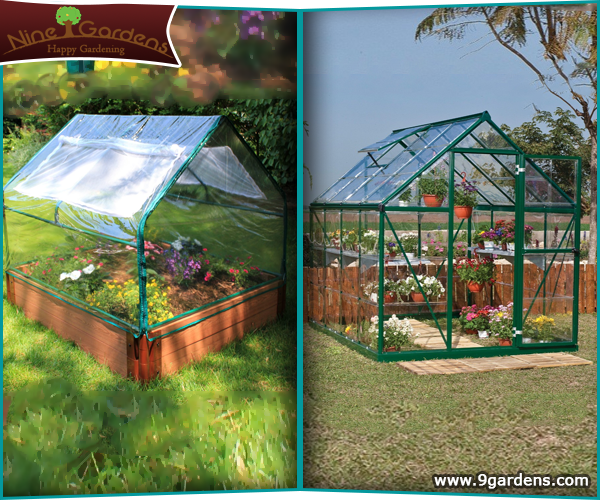
Greenhouse gardening and ‘normal’ gardening are in many ways similar. In both cases, the plants require adequate nutrients and water, as well as protection from insects, pests and diseases. Both gardens thus require tending and pruning.
The chief difference between greenhouse gardening and outdoor gardening is the degree of environmental control each form allows the gardener. In a greenhouse, the gardener controls temperature, humidity, soil aeration, soil moisture and drainage, fertility levels and light. Yet the very things that make greenhouse growing more controlled and convenient also make it more demanding.
Temperature: Even in a well-designed solar-efficient greenhouse, outside conditions are sometimes so cold and cloudy that artificial heat may be needed to keep plants growing at an optimum rate. Heaters, vents, and fans are your allies in temperature control. Heaters may be used to increase temperature while vents and fans help to cool the greenhouse. While installing these systems, however, one must first investigate the temperature requirements of the plants one plans to grow.
Air circulation: Air circulation is extremely important to plant health. Good air circulation strengthens the woody tissue in stems and decreases susceptibility to such things as fungi. Dense plant growth can interfere with air circulation and contribute to excessive relative humidity. One must thus be sure to leave adequate space between plants and prune regularly so that leaves from adjacent plants do not touch each other.
Besides vents and fans, another, more cost-effective way to increase air movement is by installing screened windows and doors. Opening a window on one end and the door panel on the other creates cross-ventilation. Further, positioning windows at the top and bottom of the greenhouse walls allows warm air to rise and escape from the upper windows, and cooler air to enter through the lower ones.
Light: Lighting in a greenhouse is partially determined by its design. When planning a greenhouse, therefore, check shade patterns from roof overhangs at the summer solstice in June and modify the plan if the shade is too great.
Fluorescent lights and HID (high-intensity discharge) systems are great sources of auxiliary light. HID systems are particularly effective for those plants that typically require copious amounts of sunlight.
Whatever system you choose, it may be wise to add a timer. This will give you control over the amount of light your plants receive without having to worry about turning the lights on and off manually. Timers can also control automated watering and mist systems, fans, heaters, and other equipment.
Soils and fertility: Home greenhouse gardeners prefer to use containers rather than amend the soil within their greenhouse. Soil mixes for containers, benches, and beds should be lighter and more fertile than most garden soils. Good soil mixes drain fast, hold moisture well, contain balanced and slow-release organic nutrients, and have a slightly acid pH. It is advisable to use organic potting mix as well.
In addition to this, composting and fertilisation must be carried out regularly. Good mid-season fertilizers include compost tea and side dressings, earthworm castings, liquid fish emulsion, and seaweed. Fertilize less in winter, when cool soil temperatures inhibit microbial activity.
Greenhouse gardening is thus immense work. Yet its rewards far outweigh the efforts and the costs.
]]>Water garden when set up with proper aquatic plants and small fishes like guppies and goldfish, will thrive well on its own.

Image Source:apartmenttherapy.com and typepad.com
The fishes help to get rid of the unwanted insects. We would advise you to reduce the quantity of food you usually feed your fishes so that they are encouraged to feed on the excessive algae, mosquito larvae and other unwanted insects.
Aquatic plants besides being attractive provide numerous benefits to your water garden. They not only help to keep the water temperature cooler for the fishes by disrupting the intense sunlight but also give nourishment to the fishes. Rooted plants are known to reduce algae build up.
During the hot summers keep checking for the level of water as water may evaporate due to excessive heat. You need to maintain the water level of your pool.
Keep checking and removing the unwanted leaves and rubble to prevent clogging of the pump. In small pools the ammonia, which is produced as waste products by the fishes may build-up excessively and kill them so it is essential to drain the water and clean the lining monthly, if your water garden is small and yearly, if it is very big in size.
This will help you to keep the pool clean and also keep your plants and fishes alive for longer.
http://www.aquascapeinc.com/ownermanualmaintenance
http://tlc.howstuffworks.com/home/how-to-grow-a-specialty-garden7.htm
]]>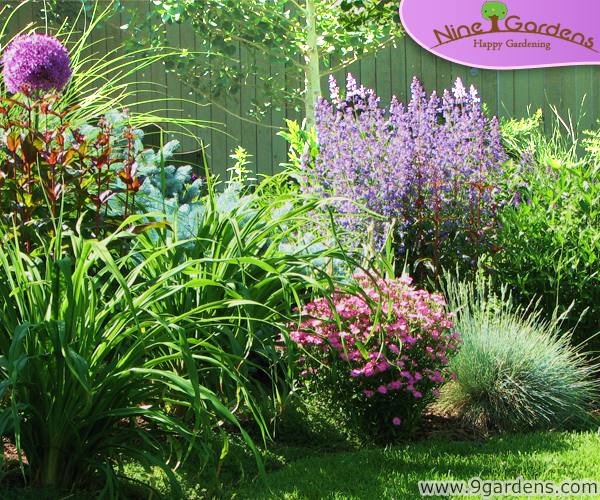
Image source:homeadvisorhomesource.com
If you have watched your garden, you would find that the various plants, shrubs and vines present look different at different times in the year. Nature understands the necessity of variety. It thus ensures that, though the gardener may grow but a few different types of plants, each plant looks different everyday so that the gardener’s experience may differ from day to day.
Spring typically begins in March and ends in early May. It is the season that heralds the coming of summer, as dawn does the morning. Spring revives the life of the garden, awakening the various creatures after the long winter months. Spring is thus the best time to begin planting. It also the season during which pollination takes place. Further, already planted species may begin to appear fresh and sweet after the relatively dry winter season.
Spring heralds the coming of leafy summer. The orchards and fields and forests are in full bloom during this season. The fragrance of spring is heightened during the summer months. Such flowers as the yellow glorious daisies, pink and orange dahlias, and lavender-pink coneflowers, which huddle next to the pink dahlias add fragrance and colour to the garden, ensuring that the summer months are ones filled with colour and vitality.
After summer, autumn may appear lifeless and dreary. Yet it too presents varying colours and a beauty that, though more subtle than the vital colours of summer, is nonetheless awe inspiring. There are several flowers and shrubs that thrive during the autumn. These include the acacia, gladiolus, bamboo, cheery pansies (pictured), snapdragons and English daisies. Though these plants may lend colours in softer tones, their beauty is undeniably reviving.
Autumn slowly melts into winter.December, January and February are typically the most barren months in nature’s yearly cycle. Yet winter too lends beauty to man’s life. In North India, such flowering plants as the cornflower, gazania, salvia and pansy brave the cold winter months and lend colour and vitality to the otherwise snow covered landscape.
Each new season thus heralds a new kind of beauty that nature wishes man to behold. Be it the seasons of spring, summer, winter and autumn, or, as is experienced in India, summer monsoon and winter, every season has a freshness that only nature knows how to provide. It is no wonder, then, that nature and its dynamic beauty served as inspiration for several poets, including Coleridge who, in the poem ‘Frost at Midnight’, enumerates the various things his son may learn from the various seasons and aspects of nature. He concludes his poem by promising him:
“all seasons shall be sweet to thee,
Whether the summer clothe the general earth
With greenness, or the redbreast sit and sing
Betwixt the tufts of snow on the bare branch
Of mossy apple-tree, while the nigh thatch
Smokes in the sun-thaw; whether the eave-drops fall
Heard only in the trances of the blast,
Or if the secret ministry of frost
Shall hang them up in silent icicles,
Quietly shining to the quiet Moon.”
]]>
Image Source: composterconnection.com; photobucket.com
There are several things we do wrong upon first trying our hand at gardening. The tips enumerated below are an attempt to aid you in ensuring that you make as few mistakes as possible.
Water is essential to plant growth and development. When it comes to watering the garden, gardeners commit two errors – they either water them too much or don’t water them at all. Different plants possess different moisture requirements. Therefore, in order to ensure that you are providing each plant with the right amount of water, you must check the soil regularly. Stick your finger into the soil up to the second knuckle. If the soil is moist until this point, it does not require water yet. Water the plant only if the soil is dry.
Space- Many of us would have had to endure the retelling of the story of how a man grew a tree in a tiny pot and expected it to grow tall and free. Quite obviously, the tree’s growth was stunted. Different plants require different amounts of space. You need to first understand which plants to grow in small spaces and which ones to grow in spacious lawns. It is important, therefore, to pay attention to the instructions on the tag or in plant catalogues for spacing your plants. If the empty space between perennial saplings is not aesthetically pleasing,grow annuals in this space until the perennials grow fully. Do not, however, grow two perennials too close to each other and expect anything but a tangled mess.
Sunlight- Knowing whether your plant requires sun or shade is of extreme importance to plant growth and development. Do not expect, for example, a tomato plant to grow well and provide fruit if you grow it along a north-facing wall under a tree. When planning your garden, be sure to choose plants that will thrive under the conditions found in your garden. Generally, such requirements may once again be found on plant tags, or in catalogue descriptions.
Fertilisers-Fertilisation is important in order to maintain the nutrient level of the soil. However, as with watering, gardeners commit either one of these fatal mistakes – they either overdo it or don’t do it at all. Firstly, when fertilising, it is better to use organic rather than chemical fertiliser. Organic fertiliser may be bought or made at home through the process of composting. In this process, one converts organic waste into fertiliser. Secondly, while it is important to fertilise, be sure to use the amount specified on the packet or that has been advised to you by the nursery.
Mulching-Mulching involves the placement of a layer of material to the surface of an area of soil.Many different materials can be used to cover the soil’s surface, including bark chippings, leaf mould, well-rotted farmyard manure, small pebbles or crushed shells. The process has many benefits. It provides nutrients for plants, locks in moisture, forms a barrier against weeds and can help insulate the roots of vulnerable plants from winter cold. It may also be used to decorate the tops of pots.
These are but some of the areas wherein one must be careful in order to ensure prolonged plant life. All in all, it is important to realise that, though plants may be immobile, they too require great amount of care. Though one learns from one’s mistakes, therefore, one must be sure to take all precautions before attempting to grow anything, be it grass or a tree.
]]>If there is no longer sufficient outdoor space to plan and plant a garden, then bring your garden into your home.

Image Source: freshinterior.me and timeinc.net
Living space has grown increasingly small. This is particularly true in urban areas. Several individuals’ homes are apartments or rather small houses that may include but a tiny porch, balcony, or patio. The ability to accord space for cultivating an elaborate garden has thus grown increasingly improbable. Yet gardening may still be practiced despite limited space. A patio, balcony, even a container could serve as a beautiful garden. A single, well-placed container can add personality and colour to a small space. All it requires is effort and innovation.
The urban home dweller need no longer check his love for the Green World at the door. One may instead welcome a piece of that world into his apartment or suburban home. Several plants may be cultivated within the confines of one’s home. Ferns, begonias, even dwarf trees may be grown in the study, in the kitchen, even in the bedroom.
Indoor gardening, though not a modern concept, is a fast evolving form of gardening. Several species of plants thrive in indoor environments and may thus be used for decorative and perhaps even consumptive purposes.
Soil is an important factor that determines the growth of any plant. The potting soil should typically be tailored to the particular type of plant being grown. Cactus, succulents and rosemary, for example, prefer a coarse, well-drained soil that is about one-third sand. Seedlings require a light, moisture-retentive, soilless mix. Ferns prefer soil with a high humus content, which can be achieved by adding leaf mould or shredded bark. All soil, however, must be well aerated and moisture retentive.
In their natural habitat, most plants experience a day-to-night temperature fluctuation. By simulating this fluctuation, one furthers the wellbeing of the plant. Further, a humidity level of at least 30% must be maintained. This allows the plants’ leaves and roots to retain water. Since indoor air has humidity levels of approximately 20%, one must carry out such steps as misting the plants for an hour or so. One may also place the plants on a gravel-filled tray that contains about 1/4 inch of water. As the water evaporates, it will humidify the air around the plants. One must be careful not to allow the pots to sit directly in the water.
As sunshine is relatively less indoors, plants require less water. Resist the temptation to water your plants every day. More houseplants die from overwatering than from anything else. Instead, water the plants only when the soil feels dry to your fingers. Whenever possible, try to water your plants with room temperature water to avoid shocking the roots. Further, the water used must not be chemically softened. If possible, collect rain water to water your plants, as that is the best choice.
As with water, indoor plants do not require heavy fertilisation. When fertilising, therefore, merely follow the instructions on the package, or add less to the soil than is required. Always water your plants thoroughly before applying any sort of fertilizer. As with outdoor plants, natural fertiliser that may be formed through composting and mulching is better than store bought fertiliser.
Light, specifically sunlight is essential for plant growth. Plants differ greatly in their need for light. Knowing the light requirements for each of your plants will allow you to determine where they will thrive. Most flowering plants, and some foliage plants, need to be within 3 feet of a sunny, south-facing window. Plants that prefer bright, indirect light can be located 3 to 5 feet away from a south-facing window, or within 3 feet of an east- or west-facing window. Plants that require diffused light can be placed 6 to 8 feet away from a south-facing window, or within a foot of a north-facing window.
During the winter months, move all of the plants closer to the window in order to compensate for the decrease in light. Most plants perform best when they receive 12 to 16 hours of light per day. If you want to keep your plants blooming during the short days of winter, you may need to provide supplemental lighting.
Gardening need no longer be merely an outdoor activity, being negated due to lack of space. Instead, one may brighten any room in the house by utilising these helpful tips and a bit of TLC.
So let us make every corner of our house beautiful!!!
References:
http://www.gardeners.com/Indoor-Gardening/5079,default,pg.html
http://www.canadiangardening.com/gardens/indoor-gardening
http://www.marthastewart.com/359993/indoor-gardens
]]>

Photo Credit: topnews.in
gro-organic.co.uk and greencirclegarden.com
In his book ‘The Enabling Garden’, Gene Rothert depicts the ability of men and women to garden despite being differently abled. He speaks of various tools and techniques that may be used by these individuals so that they may enjoy the experience of gardening without difficulty. Gardening then, would no longer be, a hobby enjoyed by one part of society alone. All may engage and reap the benefits of gardening.
In order to be able to garden with ease, there are several simple techniques that may be employed. We tell you how easily your garden can be customised for having an effortless gardening experience!
The first and most important thing to do is to raise the soil level- Raised beds or planters at the right height not only looks attractive but also makes gardening easier for people with difficulties in bending or kneeling. In this way you will be able to tend the plants with ease and alacrity. Raised beds are usually built as bottomless boxes containing large amounts of soil that are open for drainage below. Plants that require great care, particularly vegetables, may be planted in raised beds.
A large garden can be difficult to maintain. Using planters or containers offer a solution to the problem. Containers provide accessibility, are compact, cost effective and may be used to grow several plants including various fruits, shrubs and herbs, thus creating a small garden that can be placed anywhere.
Table planters are another means of accessible gardening. They are easily made containers, usually built with a table top with depth of about 6 to 12 inches for soil and with width and length dimensions. They are easily adjustable and therefore suitable for seated gardeners.
Another way of growing plants, vertical gardening, is a wonderful way to use the small spaces and is particularly helpful to people using wheelchairs or those who wish to avoid bending and stooping. Try taller container planting, or train a climber up a wall or fence. You could also use window boxes or other wall or fence-mounted containers, or a table or open shelving for more containers.
If you wish to have a water garden, make sure to have wildlife ponds with small sized fishes in it. Also opt for small sized, water plants with slow growth rate. Plants that require low maintenance or has a slow growth rate would be a good choice as it saves you from the efforts and continuous vigilance which may otherwise have been necessary to maintain them.
Using ground cover plants for your lawns can help to reduce the emergence of weeds and save you from the laborious task of weeding.
Moving things around the garden can be made easier with the use of light- weight wheeled trolleys, carts and buckets which are easily movable. Having seats in some shady areas is necessary so that you can relax for a while.
Finally, make sure your garden paths are not slippery and provide good traction, this will help you to move around the garden safely and with ease.
Anybody can enjoy the benefits of gardening.
Happy Gardening!!!
References:
http://www.christopherreeve.org/site/c.mtKZKgMWKwG/b.5300837/k.7D2E/Gardening_from_a_Wheelchair.htm
]]>
Plants and trees have been known to maintain oxygen levels in the atmosphere since the beginning of time. The leaves of the plants in your house carry out the important task of absorbing carbon dioxide and releasing oxygen. In this way, plants and trees act as ‘natural sinks’ for such gases as carbon dioxide and carbon monoxide which in excess would be harmful to human life.
The cause of over 50% of illnesses is indoor pollution, which is a growing problem, particularly in urban areas. It is refreshing to learn, therefore, that several common houseplant varieties can essentially clean the air of certain chemicals, including carcinogens like trichloroethylene, formaldehyde, and benzene.
Rather than spending copious amounts of money on air purifiers and humidifiers, you may instead spend but a small amount on a plant and some dirt for the same or even better effects. By planting, one plant for every 100 square feet of your home as Dr. Clifford W. Bassett, of New York University’s School of Medicine suggests, you may negate any harmful traces of pollution, specifically air pollution.
According to NASA’s ‘Interior Landscape Plants for Indoor Air Pollutant Abatement’ report, the plants found to be most effective at purifying the air include Peace lilies, Mother-in-law’s tongue, Ficus, Gerbera daisies and Devil’s ivy.
As stated above, common houseplants may also be used as air purifiers. Such plants include Chrysanthemum (Chrysantheiummorifolium), Poinsettia (Euphorbia pulcherrima), Bamboo palm (Chamaedoreasefritzii), Red-Edge dracaena (Dracaena marginata) and Spider plant (Chlorophytumcomosum). These plants also provide the added benefit of adding a splash of colour and natural beauty to the home.
Air purification is thus a great necessity, particularly in urban spaces, where ventilation within the household is generally poor and air quality is generally low. Plants thus provide to their planters a great number of gifts. In this case, they provide the greatest gift of all – the gift of a healthy life.
References:
http://www.trueactivist.com/want-cleaner-and-purer-air-try-air-cleaning-plants-nasa-says/
]]>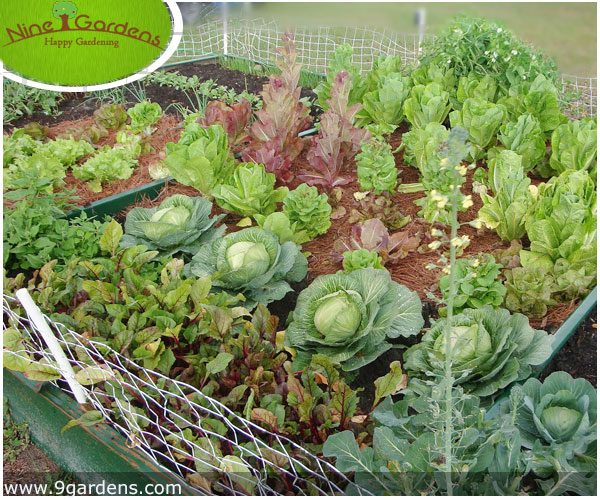
Maintaining a vegetable garden is both a healthier and a cost effective activity. There are, however, several important points that must be remembered while tending to such a garden.
Soil is an important component in ensuring the growth of healthy plant life. The soil upon which one may plant a vegetable garden must possess enough nutrients to support plant growth and healthy development. Composting is thus an essential task. The manure used may be homemade or store bought, but it is always better to use natural fertilizer. It is also important to ensure that the manure is well spread and turned periodically before one seeds the soil. This ensures that the nutrients enter layers other than the topsoil.
In ensuring nutrient content of the plant, the gardener may employ several methods. Cover cropping, organic compost made from biodegradable household waste, and dry and fluid fertilisers including fish meal, kelp meal and rock phosphate, usually deliver specific nutrients to the soil. They are useful for addressing soil deficiencies of major nutrients or trace minerals or for adding to specific vegetable crops that benefit from specific nutrients
In order to ensure that the nutrients are utilised for vegetable growth alone, one must undertake the task of weeding one’s garden regularly. This negates a slow development process or even possibly death for the plants.
Apart from ensuring nutrient content, one must also ensure that the soil maintains its moisture level. The plants must thus be watered regularly; in some cases every day. It is helpful to note that rainwater is perhaps the best form of water that may be utilised. Therefore, it would be beneficial if one were to collect rainwater in buckets or through the process of rainwater harvesting so that one may water one’s plants with it when it does not rain.
Over time, the soil may begin to harden.In such a case, one must be sure to ‘settle’ the soil so that it may loosen and increase the arability of the root.one must be careful, however,to loosen the soil above and around the roots so that one does not break them.
Climatic conditions must also be adherent to plant growth and development. Vegetable plants typically require large amounts of sunlight and water. They must thus be placed in typically sunny regions of the garden: one must be careful not to plant vegetable seeds too close to trees or other tall vegetation.
As the vegetable plants grow, one may aid the growing process by clipping off the farthest leaves on the plants’ branches. This allows the nutrients that went to these leaves to be utilised in the overall development of the plant.Further, as the vegetable plants mature, one may clip off any undergrowth or any small branches so as to further the growth of the vegetables.
Vegetable gardening thus possesses great benefits, especially for the health conscious. It does, however require a great amount of time, patience and skill.
Reference:
http://www.weekendgardener.net/vegetable-gardening-tips/maintain-garden-060706.htmces:
]]>
The practice of gardening has evolved over years, both in terms of methods as well as reasons for undertaking this activity. Historically, gardening was an activity of necessity – it ensured the cultivation of fruits, vegetables and food grains for consumption. Now, however, it has become a form of recreation, a hobby and even a successful form of therapy.
There are several types of gardening, as varied as are the benefits of engaging in the activity.Outdoor gardening is undoubtedly the most traditional type of gardening and is considered by many to be the most enjoyable. Such gardening involves open spaces, preferably large open spaces that allow the garden space to grow and cultivate varied types of plants including fruits, vegetables and shrubs. As a recreational activity, it not only provides the gardener with a form of physical exercise, it provides for mental rest and spiritual growth as well.
Indoor gardening brings the benefits of maintaining a garden into the confines of a home. Such a practice provides for aesthetically pleasing natural decor, as well as improvement of indoor air quality, particularly in recently constructed buildings where proper air ventilation is not always provided. Indoor gardening is ideal for the inexperienced gardener as it requires minimal attention to maintenance, particularly in comparison to outdoor gardening. Preferred plants grown through this technique include English ivy, spider plant, peace lily, Chinese evergreen, bamboo or reed palm, snake plant, heartleaf philodendron, dracaena and weeping fig.
Container gardening is an ever evolving and increasingly attractive method of gardening, rather than growing plants in large outdoor spaces. With containers, even gardeners living in urban apartments can grow food, herbs, flowers and foliage in sunny windows or on balconies and rooftops. Container gardening eliminates the problems of weeds, most soil-borne diseases and gives the gardener ultimate control over moisture, sunlight and temperature.
Water gardening is another evolving form of gardening. Such a garden may be formed from anything - a pond or half-barrel, an old bathtub or waterproof planter. Water gardens are typically made to include aquatic plants, fish and other aquatic life. They may include a couple of plants in a bowl, or they may be large, complex ponds fitted with waterfalls, filters and many different types of plants. It’s fairly simple to put a water garden together; the most basic items that you need are leakproof containers, potted aquatic plants, pea gravel and clean, fresh water. Common aquatic plants for water gardens include wild celery, dwarf papyrus, water hyacinth and water lettuce.
The final form of gardening is community gardening. Such a form of gardening involves public spaces wherein one rents a plot of land to plant ornamental, edible and medicinal plants as per one’s interest. Such gardens provide access to fresh produce, as well as beautify neighbourhoods. Perhaps most importantly, they provide a sense of community and connection to the environment. Some community gardens are tended communally, allowing everyone who helps out in the garden to have a share of its bounty.
Gardening is thus a varied activity, both in terms of method used as well as in the types of plants chosen and the location of the garden. No matter what type of gardening one undertakes, however, the benefits of undertaking the activity are usually similar and equally rewarding.
References:
]]> Ingredients
Ingredients
- 1 country-style roast chicken (Woolworths brand)
- 8 medium red radishes, washed, dried, ends trimmed, coarsely grated
- 235g (1 cup) good-quality whole-egg mayonnaise
- 2/3 cup finely shredded fresh mint
- Salt & freshly ground black pepper
- 24 slices whole meal bread, crusts removed
Method :
- Step 1: Remove chicken meat from bones. Discard bones, skin and seasoning. Shred chicken and place in a large bowl along with the radish, mayonnaise and mint. Stir until just combined. Taste and season with salt and pepper.
- Step 2: Place half the bread slices in a single layer on a clean work surface. Spread with chicken mixture. Top with remaining bread slices. Cut each sandwich lengthways into thirds. Secure with toothpicks. Arrange on a platter to serve.
 Ingredients
Ingredients
- 2 tablespoons plain flour
- 2 teaspoons ground cumin
- 1 garlic clove, crushed
- 2 tablespoons chopped flat-leaf parsley
- 3 green onions, thinly sliced
- 2 eggs, lightly beaten
- 3 carrots, peeled
- 2 tablespoons olive oil
- 2 green onions, extra, thinly sliced lengthways
- reduced-fat Greek-style natural yoghurt and lime wedges, to serve.
Method :
- Step 1: Combine flour, cumin, garlic, parsley and green onions in a large bowl. Add eggs. Mix well to combine.
- Step 2: Coarsely grate carrots. Use your hands to squeeze out as much excess moisture as possible. Add carrots to egg mixture. Season with salt and pepper.
- Step 3: Heat oil in a non-stick frying pan over medium heat. Add 1/4 cup of batter per fritter to frying pan. Cook fritters in batches for 3 minutes each side, or until golden and cooked through.
- Step 4: Place 2 fritters onto each serving plate. Top with extra green onions. Season with salt and pepper. Serve warm with yoghurt and lime wedges.
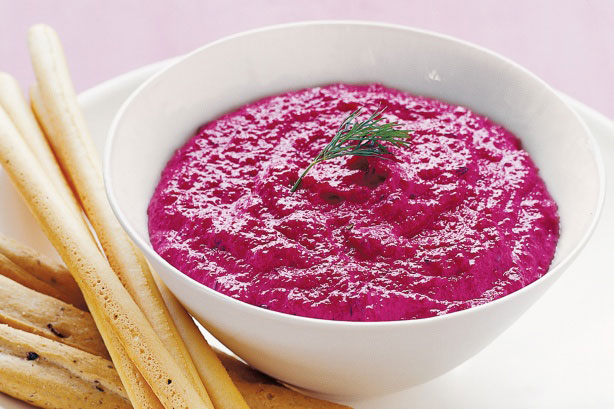 Ingredients
Ingredients
- 1 medium (about 240g) beetroot, root and stem trimmed
- 1 1/2 tbs cumin seeds
- 260g (1 cup) plain yoghurt
- 2 garlic cloves, crushed
- 1 tsp fresh thyme leaves
- Pinch of salt
- Crusty bread, to serve
Method :
- Step 1: Place the unpeeled beetroot in a medium saucepan and cover with plenty of cold water. Cover with a tight-fitting lid and bring to the boil over high heat. Remove the lid, reduce heat to medium and cook for 25 minutes or until beetroot is tender when tested with a skewer. Drain and set aside for 15 minutes or until cool enough to handle.
- Step 2: Put on rubber gloves to avoid staining your hands and peel the beetroot. Set aside for 1 hour or until cooled to room temperature.
- Step 3: Meanwhile, place the cumin seeds in a medium non-stick frying pan over medium heat. Cook, stirring constantly, for 30 seconds or until fragrant. Remove from heat and set aside.
- Step 4: Cut the beetroot into large pieces, place in the bowl of a food processor and process until smooth. Add the yoghurt, garlic and thyme, and process until well combined. Taste and season with salt.
- Step 5: Sprinkle the beetroot dip with the toasted cumin seeds and serve with the crusty bread.
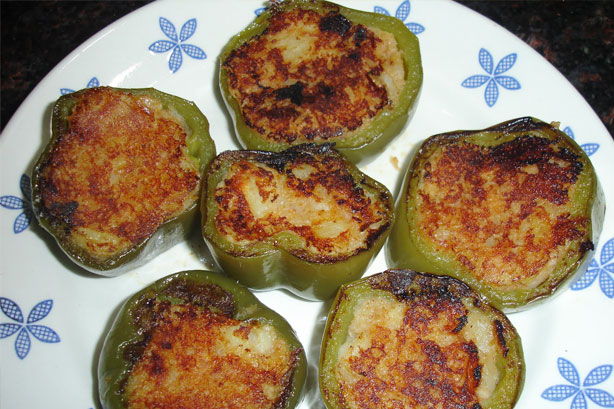 Ingredients
Ingredients
- 3 capsicum (we used red, yellow and green), halved, seeds removed
- 1/4 cup (60ml) olive oil
- 150g ricotta cheese
- 150g cherry tomatoes, halved
- 1 small red onion, thinly sliced
- Grated rind of 1 lemon
- 1 garlic clove, crushed
- 1/2 cup torn basil leaves
Method :
- Step 1: Preheat oven to 180°C.
- Step 2: Toss the capsicum in half the oil, then place on a baking tray.
- Step 3: Combine ricotta, tomatoes, onion, rind, garlic and half the basil, then use to fill the capsicum.
- Step 4: Drizzle with remaining oil and bake for 20-25 minutes. Garnish with remaining basil
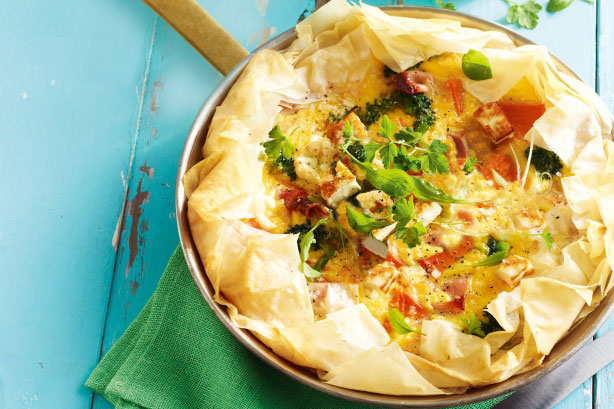 Ingredients
Ingredients
- 750g butternu
- t pumpkin, peeled, cut into 3cm pieces
- 150g broccoli, cut into florets
- 60g butter, melted
- 8 sheets filo pastry
- 100g pancetta, torn into large pieces
- 100g feta, broken into large pieces
- 8 eggs, lightly whisked
- 2 tsp olive oil
- 125g haloumi, cut into 2cm pieces
- 2 tsp fresh lemon juice
- 15g baby rocket leaves
- 1/2 cup small fresh continental parsley leaves
- 1 shallot, trimmed, thinly sliced diagonally
Method :
- Step 1: Preheat oven to 180ºC. Place pumpkin in a steamer basket over a saucepan of boiling water. Cover. Steam for 15 minutes or until just tender. Transfer to a plate. Add the broccoli to the steamer basket. Steam for 5 minutes or until bright green and tender crisp.
- Step 2: Meanwhile, lightly grease a 26cm (top measurement) ovenproof frying pan with a little of the melted butter. Place the filo on a clean work surface. Cover with a dry tea towel, then a damp tea towel (this prevents it from drying out). Brush 1 filo sheet with a little of the melted butter. Fold in half, crossways. Place in the pan, allowing it to overhang slightly. Repeat with remaining filo and melted butter, turning and overlapping each sheet slightly to line the pan completely.
- Step 3: Arrange the pumpkin, broccoli, pancetta and feta evenly over the filo. Pour over the egg. Fold the pastry over the filling to slightly enclose. Bake for 35-40 minutes or until set and golden.
- Step 4: Heat the oil in a small frying pan over medium-high heat. Add the haloumi and cook, turning occasionally, for 2 minutes or until golden. Add the lemon juice and toss to coat.
- Step 5: Combine haloumi, rocket, parsley and shallot in a bowl. Top the frittata with a little haloumi salad. Serve with the remaining salad.
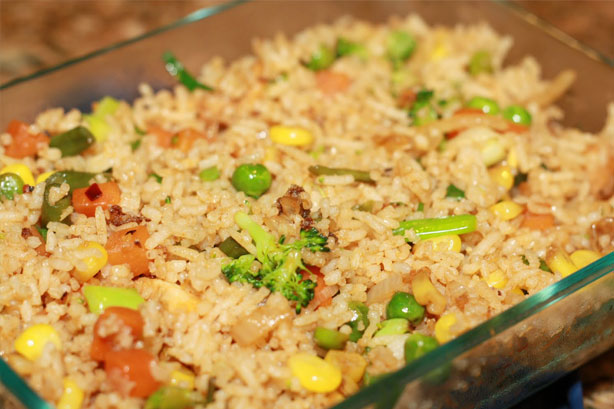
- Preparation Time: 15 mins.
- Cooking Time: 10 minutes
- Serves: 4
For The Creamy Vegetables
- 2 tbsp oil
- 10 to 12 cauliflower or
- broccoli floret , parboiled
- 8 to 10 baby corn , sliced
Diagonally and parboiled
- 1/4 cup capsicum cubes
- 3/4 cup sliced carrots , parboiled
- 1/4 cup sliced spring onions
- 1/4 cup sliced cucumber
- 1/3 cup milk
- 1 tbsp cornflour
- 2 pinches sugar
- salt to taste
For Serving
- 2 cups Chinese rice
Method :
For the creamy vegetables
- Step 1: Heat the oil in a wok or kadhai on a high flame till it smokes.
- Step 2: Add the cauliflower, baby corn, capsicum, carrots, spring onions, cucumber and sauté on a high flame for 2 minutes.
- Step 3: Combine the milk, cornflour and ½ cup of water in a bowl and mix well.
- Step 4: Add to the vegetables, mix well and cook on a high flame for a minute (if the mixture is too thick, add a little more water).
- Step 5: Add the sugar and salt and cook on a high flame for another few minutes, while stirring continuously.
How to proceed
- Step 1: Place the rice in a serving dish, top with the creamy vegetables and serve immediately.
]]>
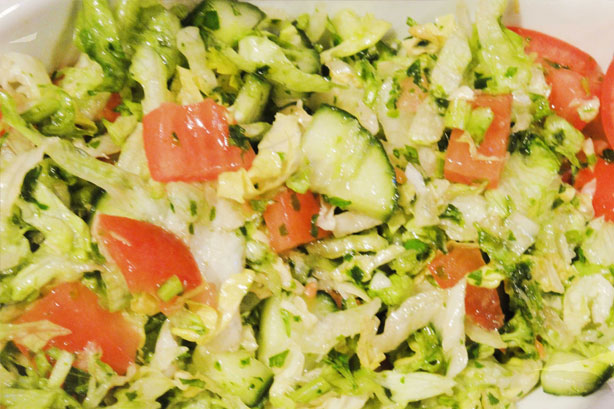
- Preparation Time: 5 mins.
- Serve: 4
- 1 cup iceberg lettuce, torn into pieces
- 1/2 cup cherry tomatoes, halved
- 1/2 cup cucumber cubes
- 5 green olives
- 5 black olives
- 1/2 cup chopped mint leaves (phudina)
To be mixed into a dressing
- 2 tbsp lemon juice
- 1/2 tsp Baharat
- 1/4 tsp pomegranate (anardana) powder
- salt to taste
Method :
- Combine all the ingredients, pour the dressing on top and serve immediately.
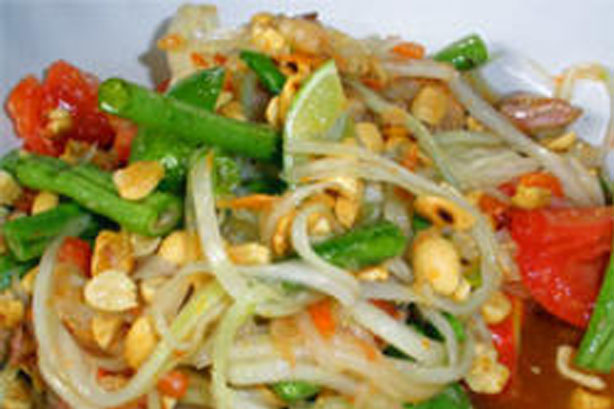
- Preparation Time: 5 mins.
- Cooking Time: 2 minutes
- Serves: 4
- 1/2 cup spring onion cubes
- 1/2 cup fresh mushrooms (khumbh), sliced
- 1/2 cup blanched and cubed baby corn
- 3/4 cup bean sprouts
- 1/2 cup red and green capsicum cubes
- 1/2 cup cucumber cubes
For the dressing
- 1 tbsp olive oil
- 3 cloves finely chopped garlic (lehsun)
- 1 tbsp finely chopped fresh basil leaves
- 2 tsp lemon juice
- 1 tsp sugar
- salt and black pepper (kalimirch) powder to taste
Method :
For the dressing
- Step 1: Heat the oil in a non-stick pan, add the garlic and sauté till it browns lightly.
- Step 2: Add the basil leaves and mix well. Cool completely.
- Step 3: Add the lemon juice, sugar, salt and pepper and mix well.
How to proceed
- Step 1: Combine all the ingredients in a bowl and toss lightly. Refrigerate.
- Step 2: Just before serving, add the dressing to the salad and toss well.
- Step 3: Serve immediately.
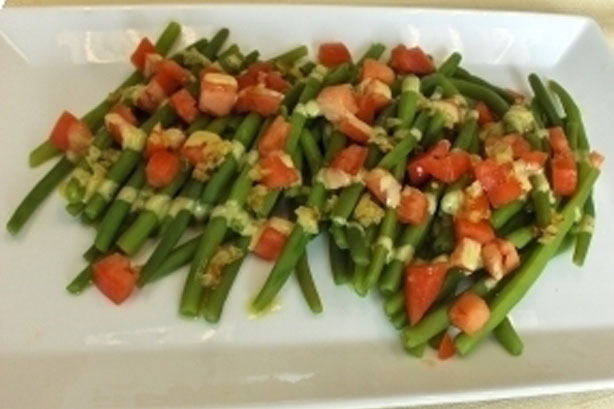
- Preparation Time: 10 mins.
- Cooking Time: 10 mins.
- Makes 8ghughras.
Ingredients
For The Dough
- 1/2 cup plain flour (maida)
- 1/2 cup whole wheat flour (gehunkaatta)
- 1 tbsp melted ghee
- salt to taste
For The Stuffing
- 1 1/2 cups chopped french beans
- 1/4 tsp asafoetida (hing)
- 1 tsp ginger-green chilli paste
- a pinch soda bi-carb
- 1 tbsp chopped coriander (dhania)
- 1 tbsp lemon juice
- 1/2 tsp sugar
- 1 tbsp raisins (kismis)
- 1 tbsp oil
- salt to taste
Other Ingredients
- oil for deep frying
Method :
For the dough
- Step 1: Combine all the ingredients in a bowl, mix well, add enough water and knead into a firm dough.
- Step 2: Cover with a damp muslin cloth and keep aside for 10-15 minutes.
- Step 3: Divide the dough into 8 equal portions, cover again and keep aside.
For the stuffing
- Step 1: Heat the oil in a kadhai, add the asafoetida and sauté for 10 seconds.
- Step 2: Add the french beans, soda bi-carb, salt and a little water, mix well and sauté for 2 minutes.
- Step 3: Add the ginger-green chilli paste and mix well. Cover and cook till the beans are almost cooked.
- Step 4: Remove the lid and allow the mixture to become dry.
- Step 5: Add the coriander, sugar, lemon juice and raisins and mix well. Remove from the flame and keep aside to cool.
- Step 6: Divide the mixture into 8 equal portions and keep aside.
How to proceed
- Step 1: Roll out each portion of the dough into a 75mm. (3”) diameter circle.
- Step 2: Place a spoonful of the stuffing at the centre of each circle.
- Step 3: Gently fold the circle into a semicircle and seal the edges using a little water.
- Step 4: Use the fork to press the sides and get a serrated edge.
- Step 5: Trim the edges using a pastry trimmer, trim the edges to get a nearly finished and secured sealed ghughra.
- Step 6: Twist the sealed edges carefully with the thumb and forefinger to make a decorative edge. Complete a semi circle to make this border.
- Step 7: Repeat the steps 2 to 6 to make more ghughras.
- Step 8: Heat the oil in a kadhai and deep fry the ghughras till they turn golden brown and crisp from all the sides.
- Step 9: Drain on an absorbent paper and serve hot.
]]>
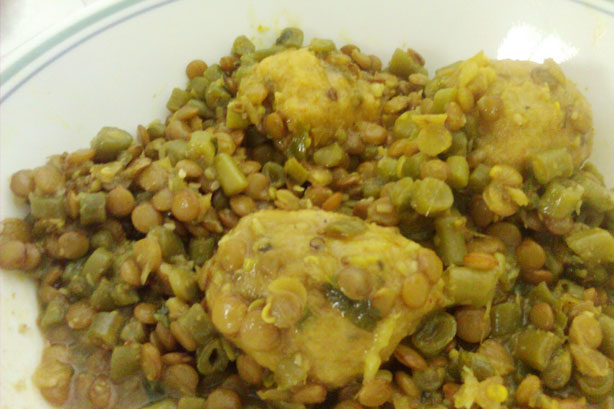
- Preparation Time: 15 mins.
- Cooking Time: 20 mins.
- Serves: 4 servings.
Ingredients
For The Dhoklis
- 3 tbsp besan (bengal gram flour)
- 1 tbsp whole wheat flour (gehunkaatta)
- 1/2 tsp red chilli powder
- 1/4 tsp turmeric powder (haldi)
- 1/4 tsp asafoetida (hing)
- 2 pinches carom seeds (ajwain)
- 1/2 tsp oil
- salt to taste
Other Ingredients
- 2 cups chopped french beans
- 2 tsp oil
- 1 tsp carom seeds (ajwain)
- 1/4 tsp asafoetida (hing)
- 1/2 tsp chilli powder
- a pinch sugar
- salt to taste
For The Garnish
- 1 tbsp chopped coriander (dhania)
Method :
For the dhoklis
- Step 1: Combine all the ingredients in a bowl and knead into a semi-soft dough using enough water.
- Step 2: Divide the dough into 30 to 35 small equal portions. Press each portion with your thumb to make a uniform circular mini dhokli. Keep aside.
How to proceed
- Step 1: Heat the oil in a non-stick kadhai, add the carom seeds and asafoetida and sauté for a few seconds.
- Step 2: Add the french beans, 1 cup of water, chilli powder, sugar and salt and cook on a medium flame for 5 to 7 minutes or till the french beans are almost done, stirring occasionally.
- Step 3: Add the dhoklis and simmer for another 10 to 12 minutes, while stirring occasionally.
- Step 4: Serve hot garnished with coriander.
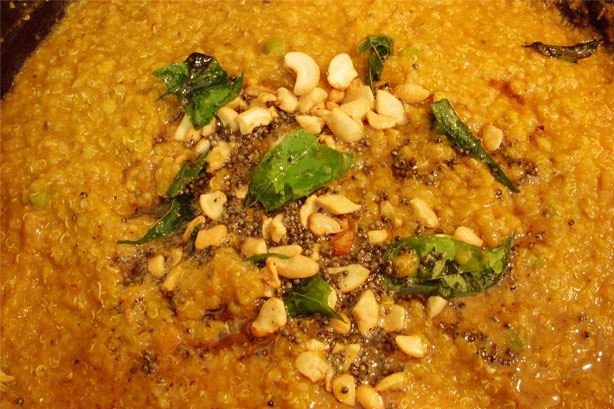
- Preparation Time: 15 mins.
- Soaking Time: 2hours.
- Cooking Time: 30 mins.
- Serves: 4 servings.
Ingredients
For The Masala (makes Approx. 1/4 Cup)
- 1 tbsp coconut oil or any other refined oil
- 1 tbsp chana dal (split Bengal gram)
- 1 tbsp urad dal (split black lentils)
- 12 mm stick ( 1/2”) cinnamon (dalchini)(optional)
- 1/4 cup grated dry coconut (kopra)
- 5 whole dry Kashmiri red chillies , broken into pieces
- 2 tbsp coriander (dhania) seeds
Other Ingredients
- 1/2 cup toovar (arhar) dal , soaked for an hour and drained.
- 2 tsp coconut oil or any other refined oil
- 1/2 tsp turmeric powder (haldi)
- salt to taste
- 1 cup raw rice (chawal)
- 1/4 cup finely chopped french beans
- 1/4 cup finely chopped carrots
- 1/2 cup finely chopped potatoes
- 1/2 cup finely chopped capsicum
- 1/4 cup shallots (madras onions)
- 1 drumsticks (saijanki phalli / saragavo) , cut into small pieces
- 5 to 7 curry leaves (kadipatta)
- 2 tbsp tamarind (imli) pulp
- 1 tbsp ghee for serving
Method :
For the masala
- Step 1: Heat the oil in a pan, add all the ingredients and saute on a slow flame for 4 to 5 minutes or till they turn golden brown in colour, while stirring continuously.
- Step 2: When cool, blend in a mixer to a fine powder. Keep aside.
How to proceed
- Step 1: Clean, wash and soak the rice for about 2 hours. Drain and keep aside.
- Step 2: Combine the toovar dal, oil, turmeric powder, salt and 6 cups of water in a deep pan, mix well, cover and cook on a medium flame for 10 to 12 minutes.
- Step 3: Add the rice, French beans, carrots, potatoes, capsicum, shallots and drumsticks, mix well and cover and cook on a medium flame for 10 to 12 minutes or till the rice and dal are cooked. (they should be soft and slightly over cooked)
- Step 4: Add the prepared masala, curry leaves and tamarind pulp, mix gently and cover and cook on a slow flame for another 5 minutes. Add the ghee and serve hot.
]]>
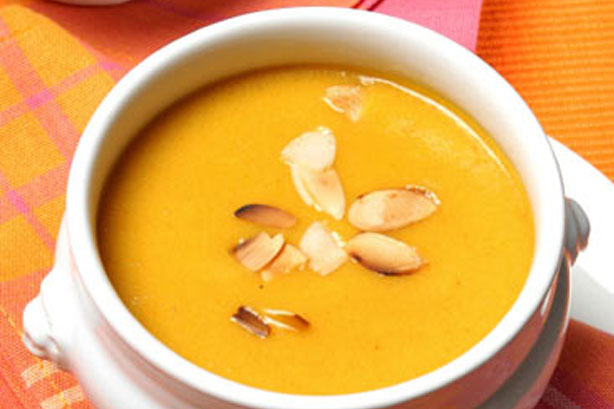 |
|
| Ingredients |
For The Garnish
|
| Method : |
|
Tips :
|
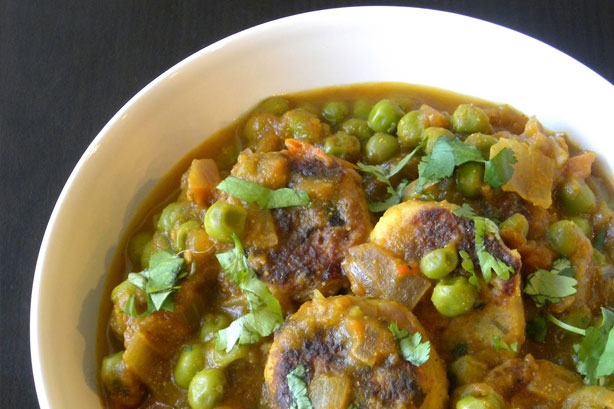
- Preparation Time: 25 mins.
- Cooking Time: 30 mins.
- Serves: 4 servings.
Ingredients
For the koftas
- 5 to 6 bread slices
- 1/3 cup curds (dahi)
- 3 tbsp levelled, plain flour (maida)
- 1 tbsp chopped coriander (dhania)
- 4 green chillies, chopped
- 2 pinches soda bi-carb
- salt to taste
- oil for deep-frying
For the pumpkin curry
- 250 gms bottle gourd (doodhi / lauki)
- 2 large tomatoes
- 3 onions, grated
- 2 tsp chilli powder
- 1 tbsp coriander-cumin seeds (dhania-jeera) powder
- 1/4 tsp turmeric powder (haldi)
- 1 tsp garam masala
- 3/4 cup fresh curds (dahi)
- 1/3 cup boiled green peas
- 3/4 cup boiled and fried small potatoes
- 3 tbsp ghee
- salt to taste
Method :
For the koftas
- Remove the crust from the bread slices.
- Soak the bread in the curds for 20 minutes.
- Add the flour, coriander, chillies, soda bi-carb and salt and mix thoroughly.
- Divide and shape into balls.
- Deep fry in oil.
For the pumpkin curry
- Peel the pumpkin and cut into big pieces.
- Add 1 1/2 teacups of water and cook. When cooked, blend in a liquidiser.
- Put the tomatoes in hot water for 10 minutes. Grate into a puree.
- Heat the ghee and fry the onions until light brown in colour.
- Add the chilli powder, coriander-cumin seed powder, turmeric powder and garam masala and fry for a few seconds.
- Add the curds, pumpkin gravy, tomato puree, 1/2 teacup of water and cook for a few minutes.
- Add the green peas, potatoes and salt.
How to serve
- When ready to serve, add the koftas to the curry and give one boil.
- Serve immediately.
]]>

- Preparation Time: 20 mins.
- Cooking Time: 35 mins.
- Serves: 4 servings.
Ingredients
For The Lauki
- 250 gms (approx.) bottle gourd (doodhi / lauki)
- 1/2 tsp salt
- 1 tsp oil
To Be Mixed Into A Filling
- 1/2 cup grated low fat paneer (cottage cheese)
- 1/4 cup finely chopped onions
- 1 tsp ginger-green chilli paste
- 2 tbsp chopped coriander (dhania)
- 1/2 tsp dried mango powder (amchur)
- 1/2 tsp coriander (dhania) powder
- 1/2 tsp chilli powder
- 1 tbsp chopped mixed dry fruits(cashew nuts , sultanas, almonds)
- 1 tsp cornflour
- salt to taste
For The Gravy
- 3 medium tomatoes , pureed
- 1 small stick cinnamon (dalchini)
- 3 cloves (laung / lavang)
- 1 tsp ginger-green chilli paste
- 1 tsp coriander (dhania) powder
- 2 tsp chilli powder
- 1/2 tsp garam masala
- 1 tsp sugar
- 2 tsp oil
- salt to taste
For The Garnish
- 2 tbsp chopped corriander (dhania)
Method :
For the lauki
- Step 1: Peel the white pumpkin, place it in a pressure cooker with 1 cup of water and the salt. Pressure cook for 1 whistle and cool.
- Step 2: Scoop out the inside pulp, discard it and keep the scooped white pumpkin aside.
- Step 3: Stuff the scooped out white pumpkin shell with the filling mixture and keep aside.
- Step 4: Heat the oil in a non-stick pan and shallow fry the stuffed pumpkin till brown spots appear on all the sides. Remove and keep aside.
For the gravy
- Step 1: Heat the oil in a non-stick pan, add the cinnamon and cloves and fry for 1 minute.
- Step 2: Add the tomato purée, ginger-green chilli paste, coriander powder, red chilli powder, garam masala, sugar and salt and cook stirring continuously till the mixture leaves oil from the sides.
- Step 3: Add ¼ cup of water and bring to a boil. Keep aside.
How to proceed
- Step 1: To serve, cut the stuffed white pumpkin into 25 mm. (1") thick slices and place them on a serving dish.
- Step 2: Pour the hot gravy over the stuffed white pumpkin slices.
- Step 3: Serve hot garnished with coriander.
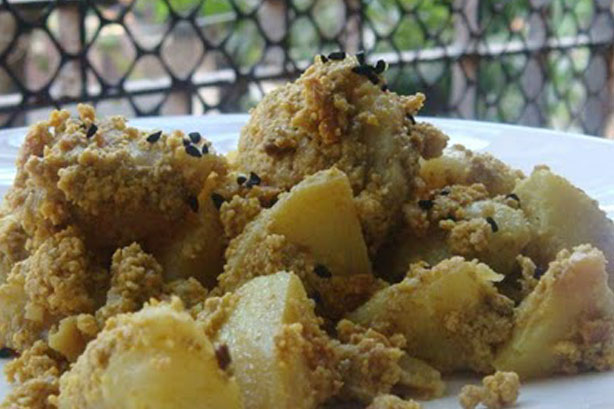
- Preparation Time: 10 mins.
- Cooking Time: 15 mins.
- Serves: 4 servings.
Ingredients
- 2 cups chopped ridge gourd (turai)
- 2 cups chopped boiled potatoes
- 1/2 cup sliced onions2 finely chopped green chillies
- 1/2 cup poppy seeds (khus-khus) , blended in a mixer along with water and salt
- 1/2 tsp turmeric powder (haldi)
- 2 tbsp oil
- salt to taste
Method :
- Step 1: Heat the oil in a pan, add the onions and saute till they turn transparent.
- Step 2: Add the turmeric powder, mix well and saute for 20 seconds.
- Step 3: Add the ridge gourd and saute till they turn soft.
- Step 4: Add the potatoes, salt and the khus-khus paste and mix well and cook till the gravy becomes thick.
- Step 5: Serve hot.

Aspire to have a beautiful garden and set off to strive for it. You can have a garden with traditional effect or you may even opt for an avant-garde and exuberant garden.
Add in a splash of color to your garden with beautiful and colorful flowers and shrubs.Create an eye-pleasing outdoor surrounding which can pull in and inspire those neighbours who aren’t into gardening like you. Creating a focal point in your garden is the best way to add a hint of uniqueness to your garden and draw the attention of people-a fountain or a large urn would serve the purpose and at the same time be classic.
Putting in significant efforts and attention to maintain the symmetry of your landscape helps your garden to appear tidy and creates a welcoming ambience.
There is nothing to feel sorry if you don’t have much space. You can still create the picturesque and lush feel by blending the elements in your garden and limiting the diversity of plant. To avert a congestion of plants, try planting most of your plants in raised beds. You can also apply certain design concepts to trick the eye and create a sense of more space. Hanging mirrors strategically at certain places can create an illusion of larger space.
Every inch of you garden is precious-so exalt your creative imagination to add a bit of dramatic effect to your garden and bring about the exotic feel.
]]>
- Preparation Time: 15 mins.
- Cooking Time: 30 mins.
- Serves: 4 to 6.
Ingredients
- 1 cup yellow moong dal (split yellow gram)
- 4 cups peeled and chopped ridge gourd (turai)
- 1 tsp ginger-green chilli paste
- 1/4 tsp turmeric powder (haldi)
- 1 cup finely chopped onions
- 1 tsp cumin seeds (jeera)
- a pinch of asafoetida (hing)
- 1 tsp chilli powder
- 1 tsp garam masala
- 1 tbsp oil
- salt to taste
For the garnish
- 1/4 cup chopped coriander (dhania)
Method :
- Step 1: Clean, wash and soak the moong dal in water for about 30 minutes. Drain.
- Step 2: Combine the moong dal, ginger-green chilli paste, turmeric powder and salt with 3 cups of water and pressure cook for 2 to 3 whistles or until the dal is cooked.
- Step 3: Whisk well to mash the dal. Keep aside.
- Step 4: Meanwhile heat the oil in a large pan and add the onions to it. Sauté for a few minutes till the onions turn translucent and then add the turai, salt and about ½ cup of water.
- Step 5: Cover and cook on a medium flame till the turai is done.
- Step 6: Add the cooked dal and ½ cup of water, if required, and bring to a boil. Keep aside.
- Step 7: For the tempering, heat the oil in a small pan, add the cumin seeds, asafoetida, chilli powder and garam masala and fry till the seeds crackle.
- Step 8: Pour this tempering over the prepared dal
- Step 9: Serve hot, garnished with the coriander.
]]>
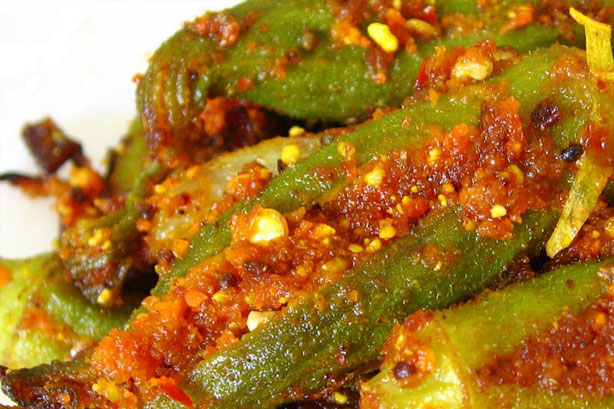
Ingredients
- 2 cups ladies finger (bhindi) , slit into four lengthwise
- 2 tbsp besan (Bengal gram flour)
- 1/4 tsp turmeric powder (haldi)
- 1 tsp chilli powder
- 2 tsp chaat masala
- 1 tsp lemon juice
- salt to taste
- oil for deep-frying
Method :
- Step 1: Mix together all the ingredients in a bowl. Toss well.
- Step 2: Heat the oil in a kadhai and deep fry the bhindi till crisp.
- Step 3: Drain on absorbent paper.
- Step 4: Serve hot
Tips:
- Step 1: These have to be fried almost immediately after you mix them as otherwise they will not be crisp as the bhindi will release water, making them soggy.
- Step 2: For the garnish, you may use chopped red capsicum and coriander as shown in the above picture.
]]>
Ingredients
- 3 cups tender ladies finger (bhindi)
- 1 tsp chaat masala
- 1/4 tsp chilli powder
- 4 tbsp oil
- salt to taste
Method :
- Step 1: Wash and dry the bhindi. Cut into very thin slices.
- Step 2: Heat the oil on a high flame in a slightly deeper tava. Add the bhindi and cook until brown and crisp.
- Step 3: Remove the bhindi from the oil and place on absorbent paper to remove the oil. Sprinkle the chaat masala, chilli powder, and salt and toss well.
- Step 4: Serve hot

Ingredients
- 2 cups ladies finger (bhindi)
- 1/4 cup oil
- 1/2 tsp asafoetida (hing)
- To Be Mixed Into A Filling
- 6 tbsp grated coconut
- 6 tbsp chopped coriander (dhania)
- 3 tsp sugar
- 1 tsp ginger-green chilli paste
- 1 tsp turmeric powder (haldi)
- 2 tsp coriander-cumin seeds (dhania-jeera) powder
- 1 tsp garam masala
- 1 tbsp sesame seeds (til)
- 2 tbsp lemon juice
- 2 tbsp oil
- salt to taste
Method :
- Step 1: Wash and cut the ladies finger into 50 mm. (2") pieces and slit lengthwise carefully, so that the segments do not separate.
- Step 2: Fill each ladies finger with a little of the prepared filling and keep aside.
- Step 3: Heat the oil in a kadhai and add the asafoetida.
- Step 4: Add the stuffed ladies finger and mix well.
- Step 5: Cover and cook on a medium flame for 15 to 20 minutes or till the ladies finger is cooked, while stirring occasionally.
- Step 6: Serve hot.
Handy tip
You can also add 2 tbsp of coarsely ground peanuts to the filling.

Ingredients
- 500 gms (approx 30 nos) ladies finger (bhindi)
- 2 tsp chopped ginger (adrak)
- 3/4 cup chopped tomatoes
- 1/4 cup fresh thick curds (dahi)
- 1/4 tsp turmeric powder (haldi)
- 3/4 tsp chilli powder
- 2 tsp coriander (dhania) powder
- 4 tbsp oil
- salt to taste
For the achaari masala
- 2 tsp fennel seeds (saunf)
- 1 tsp mustard seeds ( rai / sarson)
- 1/2 tsp nigella seeds (kalonji)
- 1/4 tsp fenugreek (methi) seeds
- a pinch of asafoetida (hing)
Method :
- Step 1: Wash, wipe dry and slit the ladies finger into half and then cut them into 25 mm. (1") pieces.
- Step 2: Heat 2 tablespoons of oil in a pan and sauté the ladies finger in it , in 2 batches. Keep aside.
- Step 3: Heat 2 tablespoons of oil another pan and add the achaari masala to it.
- Step 4: When the seeds crackle, add the ginger and tomatoes. Sauté for 5 minutes till the mixture leaves oil.
- Step 5: Meanwhile whisk together the curds, turmeric powder, chilli powder, coriander powder and salt.
- Step 6: Add this mixture to the pan, mix well and cook for a couple of minutes.
- Step 7: Add the ladies finger and simmer for 2 minutes.
- Step 8: Serve hot.
]]>

Ingredients
- Carrots – 250g (peeled and thick julienned)
- Green Chilies – 250g(cut in half long ways and cut in half again across the center)
- Salt – 2 tsp (or to taste)
- Oil – 4 Tbsp
- RaiKuria – 2 tsp
- White Vinegar – 2 tsp
- Asafoetida (Hing) – 1/8 tsp
- Lemon Juice – 1 to 2 Tbsp (according to taste)
- Additional Salt – to taste
Method :
- Step 1: In a large mixing bowl, add Carrots, Chilies and 2 tsp Salt.
- Step 2: Mix well, cover and keep aside for about 2 hours (mix in between).
- Step 3: Using a sieve, drain off all liquid which has formed in the bowl and discard.
- Step 4: Line a large tray with paper towels and spread the Carrots and Chilies in a single layer.
- Step 5: If time permits, place tray in the sun for 1-2 hours to allow the Carrots and Chilies to dry out (best option). If not, place a second layer of paper towels over the Carrots and Chilies and blot them dry.
- Step 6: In a mixing bowl, add Oil, RaiKuria, White Vinegar, Asafoetida, Lemon Juice and Salt. Whip until mixture is emulsified.
- Step 7: Add dried Carrots and Chilies and mix well to coat.
Cover and keep aside for 3-4 hours (mixing in between) before storing in the refrigerator in a clean, dry jar.
- Step 8: Shelf life is up to 1 month.
]]>

Ingredients
- 2 cups (125 grams) bhavanagarichillies (big green chillies), cut into 12 mm. (1/2") roundels
- 1/4 cup (25 grams) split mustard seeds (rainakuria)
- 1/4 cup (25 grams) fennel seeds (saunf)
- 1/2 tsp turmeric powder (haldi)
- 1/2 tspchilli powder
- 4 tbsp lemon juice
- 1/4 cup (40 grams) salt
Method :
- Step 1: Roast the fennel seeds. Pound them to a coarse powder in a mortar and pestle.
- Step 2: Combine all the ingredients and toss well.
- Step 3: Bottle in a sterlised glass jar.
This pickle is ready to eat immediately. It can be kept under the sun for 3 to 4 days so that the flavours mellow down. It stays refrigerated for upto 3 months.

Ingredients
- 8 to 10 brinjals (baingan / eggplant)
- 1/4 tsp mustard seeds ( rai / sarson)
- 1/4 tsp fenugreek (methi) seeds
- 1/4 tsp nigella seeds (kalonji)
- 8 to 10 curry leaves (kadipatta)
- 3 green chillies, slit
- 4 tbsp oil
- salt to taste
- For the coconut and sesame paste
- 2 tbsp sesame seeds (til)
- 2 tbsp grated coconut
- 2 tbsp raw peanuts
- 1 tsp chopped ginger (adrak)
- 1 tsp garlic, chopped
- 1/4 cup chopped onions
- 1/4 tsp turmeric powder (haldi)
- 1 tsp coriander (dhania) powder
- 1 tsp cumin seeds (jeera) powder
- 1 tsp chilly powder
- 1 tsp tamarind (imli) pulp
For the garnish
- 2 tbsp chopped coriander (Dania)
Method :
For the paste
- Slit the brinjals, lengthwise, into four, but leave the stems on, so the eggplants remain joined at the stem. Keep aside.
For the coconut and sesame paste
- Step 1:Combine the sesame seeds, coconut, peanuts, ginger, garlic and onions in a pan and dry roast them over a slow flame till the flavours are released and the ingredients are lightly browned.
- Step 2:Add the turmeric powder, coriander seed powder, cumin seed powder, chilli powder and tamarind paste and grind it to a smooth paste using ½ cup water. Keep aside.
How to proceed
- Step 1: Heat the oil in a deep bottomed pan, add the mustard seeds, fenugreek seeds and nigella seeds.
- Step 2: When they crackle, add the brinjals, curry leaves and green chillies and sauté over medium heat for a couple of minutes. Remove and keep aside.
- Step 3: In the same pan, add the coconut and sesame paste and cook till the mixture leaves the sides of the pan.
- Step 4: Add the cooked brinjals, ½ cup of water and salt and cook covered over a slow flame till the brinjals are soft.
- Step 5: Serve hot.

Ingredients
- 1 large brinjal (baingan / eggplant)
- 2 tbsp olive oil
- 1/2 cup finely chopped onions
- 1 tbsp chopped garlic (lehsun)
- 1/2 tsp dried red chillies flakes
- 1/4 tsp freshly ground black pepper powder
- 1 1/2 cups chopped tomatoes
- 1/2 cup red wine (optional)
- 1/2 cup fresh basil leaves , torn into pieces
- 1 cup cheese spread
- 2 tbsp parmesan cheese
- 1 1/2 cups milk
- salt to taste
Method :
- Step 1: Pierce the brinjal using a fork and roast in an open flame or an oven at 200°c till it turns soft from inside and a little charred on the outside. Peel, chop and keep aside.
- Step 2: Heat the oil in a kadhai, add the onions and sauté for a few seconds.
- Step 3: Add the garlic, and sauté till they turn golden brown. Add the red chilli flakes, pepper and tomatoes and sauté on a medium flame for a few minutes.
- Step 4: Add the red wine and basil, mix well and cook for 5 minutes.
- Step 5: Add the brinjal, salt, cheese spread and ½ cup of water, mix well and cook for 5 minutes.
- Step 6: Remove from the flame, add the parmesan cheese and mix well.
- Step 7: Add the milk and 1 cup of water, mix well and blend in a mixer into a smooth puree.
- Step 8: Serve hot.
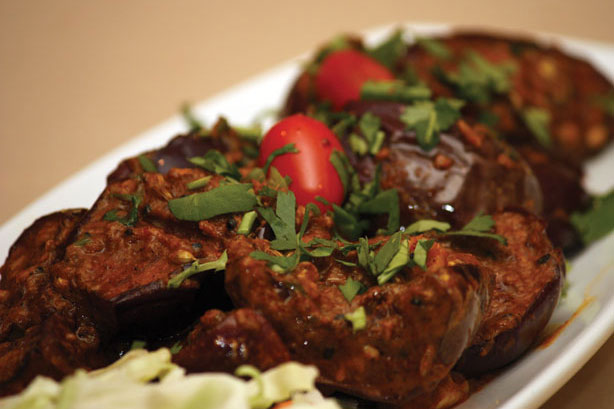
Ingredients
- small sized, dark variety brinjals (baingan / eggplant)
- 2 tbsp chopped coriander (Dania) for garnishing
- 2 tbsp coriander (Dania) seeds
- 2 tbsp cumin seeds (jeera)
- 2 tsp chilly
- 2 tsp dried mango powder (amchur)
- 2 tsp sugar
- 2 tbsp besan (Bengal gram flour)
- 1/2 cup chopped coriander (Dania)
Method :
For the paste
- Blend all the ingredients to a smooth paste using a little water if required. Keep aside.
How to proceed
- Step 1:Slit each brinjal into four equal parts lengthwise without separating the pieces from the steam. Keep aside
- Step 2: Stuff them with the prepared paste and put them in a pressure cooker. If any paste is left, spread it over the stuffed brinjals.
- Step 3: Pressure cook for 2 whistles.
- Step 4: Allow the steam escape and then open the pressure cooker. Keep aside.
- Step 5: Heat a non-stick kadhai and cook the stuffed brinjals in it on a low flame for 5 to 6 minutes or till they are tender.
- Step 4: Serve hot garnished with coriander.

Ingredients
- 375g dried spaghetti pasta
- 2 tablespoons olive oil
- 1 small red onion, halved, thinly sliced
- 2 garlic cloves, finely chopped
- 400g can Italian cherry tomatoes in tomato juice
- 1 teaspoon caster sugar
- 2 tablespoons shredded fresh basil leaves
Method :
- Step 1: Cook pasta in a large saucepan of boiling salted water, following packet directions until tender. Drain.
- Step 2: Meanwhile, heat oil in a large, deep frying pan over medium heat. Add onion. Cook for 3 minutes or until softened. Add garlic. Cook for 1 minute or until fragrant. Add tomatoes and sugar. Bring to a simmer. Cook, stirring occasionally, for 5 minutes or until slightly thickened.
- Step 3: Add basil and pasta to tomato mixture. Season with salt and pepper. Toss to combine. Serve.

Ingredients
- 8 vine-ripened tomatoes
- 1 tbs olive oil
- 1 brown onion, halved, thinly sliced
- 2 tbs pine nuts
- 150g (3/4 cup) long-grain rice
- 310ml (1 1/4) cup water
- 1 tsp ground cumin
- 1/2 tsp ground allspice
- Salt & freshly ground black pepper
- 500ml (2 cups) chicken stock
Method :
- Step 1: Preheat oven to 180°C. Use a sharp knife to slice the top off each tomato. Reserve tops. Use a teaspoon to scoop out seeds and flesh, leaving a 1cm border. Place tomato shells in a shallow roasting pan. Strain tomato pulp through a fine sieve and discard the juice. Coarsely chop tomato pulp and set aside.
- Step 2: Heat the oil in a large saucepan over medium heat. Add the onion and pine nuts and cook, stirring occasionally, for 6 minutes or until onion softens and pine nuts are golden brown. Add the rice and water, and bring to the boil. Reduce heat to low and cook, covered, for 12 minutes or until rice is tender.
- Step 3: Add the cumin, allspice and reserved tomato pulp, and stir until combined. Season with salt and pepper.
- Step 4: Spoon the rice mixture among tomato shells and top with the reserved tops. Pour over stock and cover tightly with foil. Bake in preheated oven for 45-50 minutes or until tomato is tender and filling is hot. Remove from oven.
- Step 5: Transfer to a platter to serve.
Justly said: All work and no play makes Jack a dull boy
Give your child a break! Share the joy of gardening with them and let them love your Garden just like you do.
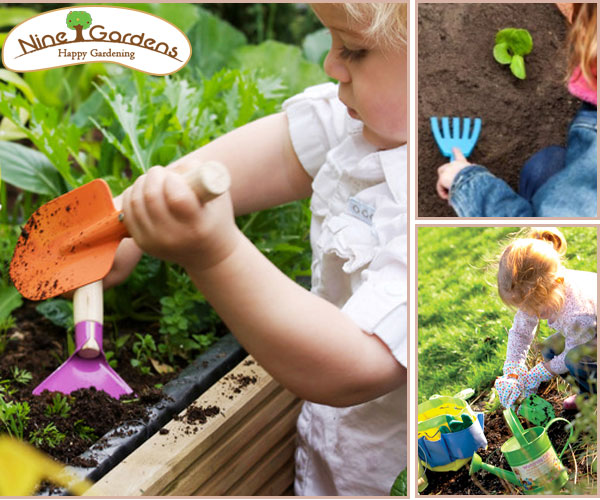
Gardening can be so much fun when the whole family gets involved. Isn’t it delighting to watch grandparents and grandchildren basking in the crusades of gardening? People of all ages can enjoy gardening. It has been found that children who grow their own food are likely to eat more vegetables. You would love to see that…isn’t it?
Your child is going to enjoy gardening if you engage them in fun activities like preparing the soil for planting, setting the plants, tending and caring for them and gleaning the fruits. Give them their own space in the garden. Let them have their small patch of vegetable, fruit or flower plants.
Along with the fun and delectation, gardening would help your child learn more about nature and its beauty. They would understand how to take care of their plants so that they grow beautifully and yield their favorite fruits, vegetables or flowers. Let them naturally understand the meaning of ‘the fruits of patience’. Caring and tending of the plants would make children more responsible. Schools which integrate gardening into the curriculum, help in the overall development of kids and are doing a wonderful work, says 9gardens.com.
Encourage your children to see, learn and understand the limitless beauty of nature, unleash their creativity and of course get some dirt on their clothes….let them just enjoy!
]]>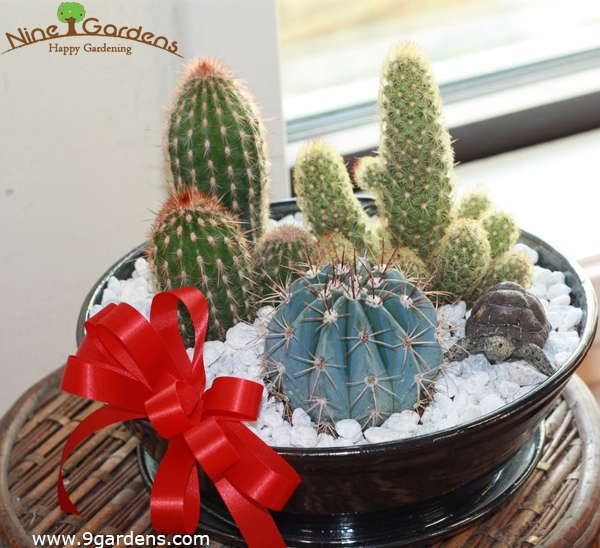
The most common way by which one kills a plant is by simply forgetting to water it. It is for this reason that cacti make for excellent houseplants. Cacti are popular for numerous reasons: their unique appearance, easy care, and long life are but a few of the advantages of growing cacti. Further, several species of cacti flower beautifully in the spring or summer, lending beautiful i shape and coloration to the household.
Most Cacti do fairly well as house plants. However, they are known to take quite a while to evolve into a fully grown cactus. Patience, sunlight and the occasional watering of the plant are essential in ensuring its healthy growth.
Sunlight is of great importance to the growth and life of a cactus. A desert plant, its various parts, particularly its fleshy stem and lack of leaves, have adapted through natural selection so as to survive harsh desert conditions. The cactus thus requires a lot of natural light, though some cacti have grown acclimatised to artificial light sources. One must be sure to save a sunny spotwithin your household and ensure that one turns the houseplant every few weeks so that its different parts are evenly illuminated. If one is growing cacti that are known to flower, then one must ensure that the plants are not moved when they are in bloom. They are very sensitive to disturbances at this stage and can drop the buds.
One of the greatest advantages of maintaining a cactus garden is the limited necessity of maintenance, especially the necessity of watering the plant daily. When one does water the plants, however, one must ensure that they are soaked adequately - like they just went through a thunderstorm. It may also increase the lifespan of the cactus if the water used is lukewarm rather than cold, for cold water may shock its roots.
As stated earlier, cacti are desert plants and are thus accustomed to arid climates and soil types. Cacti and other succulents thus prefer hot and dry conditions and a soil that affords good drainage and aeration. A preferable soil type and pot would be unglazed clay pots with a layer of course gravel along the bottom. This is primarily due to the fact that most cacti have far ranging lateral roots. Further, one must be careful not to put the cactus in too large a pot as that may lead to later problems-primarily root rot. A tall narrow pot often leads to stress and stunted growth.
The cactus is thus an ideal plant to maintain within the household. One must however be careful in ensuring that, while maintaining a relatively easy schedule for tending the cacti, one is not excessively neglectful, for no matter what the plant, gardening is an art that requires great patience and careful watchfulness.
References:
http://www.gardeningchannel.com
]]>CHERRY TOMATO & ROCKET TARTLETS
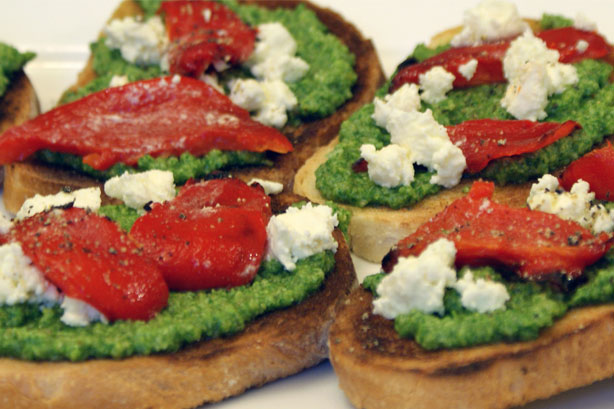
Ingredients
Frozen short crust pastry, thawed
1 cup fresh ricotta
1 tablespoon chopped fresh basil
1/2 cup finely grated parmesan
100g whole cherry tomatoes, halved
100g cherry tomatoes, halved
Rocket and oil, to serve
Method :
Preheat oven to 200°c. Line four 12cm (base measurement) fluted tart tins, with removable bases, with pastry and trim excess. Line with non-stick baking paper and fill with pastry weights or rice. Bake for 8 minutes then remove weights or rice and paper. Bake for 5 minutes or until light golden. combine ricotta, basil and parmesan in a bowl. Divide among cases and top with cherry tomatoes. Drizzle with oil and bake for 20-25 minutes or until golden. Top with rocket and drizzle with more oil..
]]>MIXED TOMATO AND HERB PIE
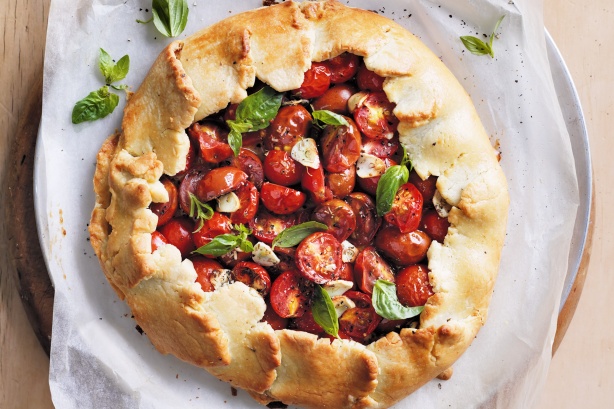
Ingredients
2 cups plain flour
150g butter, chilled, chopped
1 egg yolk
2 tablespoons chilled water
1 tablespoon olive oil
1 garlic clove, thinly sliced
1/2 teaspoon dried mixed herbs
1/3 cup finely grated parmesan cheese
200g grape kumatoes, halved (see note)
250g cherry tomatoes, halved
1 egg, lightly beaten
Baby basil leaves, to serve
Method :
Step 1:Preheat oven to 220°C/200°C fan-forced. Process flour and butter until mixture resembles breadcrumbs. Add egg yolk and chilled water. Process until mixture almost comes together, adding extra water if needed. Turn dough onto a lightly floured surface. Knead until smooth.
Step 2:Place dough between 2 sheets of baking paper. Roll out to form a 30cm round. Place on a baking tray lined with baking paper. Cover. Refrigerate for 30 minutes.
Step 3:Combine oil, garlic and mixed herbs in a jug. Sprinkle parmesan over pastry, leaving a 3cm border. Arrange tomatoes over parmesan. Spoon oil mixture over tomatoes. Fold pastry edge over filling. Brush pastry with egg. Season with salt and pepper. Bake for 30 to 35 minutes or until pastry is golden and crisp and tomatoes are tender. Stand for 5 minutes. Sprinkle with basil leaves. Serve. Note: You could use yellow or red grape tomatoes instead of kumatoes.
]]>TOMATO AND CORN MUFFINS
Ingredients
- 2 cups self-rising flour
- 1 teaspoon baking powder
- 2 tablespoons caster sugar
- 1 cup frozen corn kernels
- 1/3 cup coarsely grated cheddar or mozzarella cheese
- 1/2 cup purchased tomato salsa
- 1/4 cup milk
- 1/2 cup extra light olive oil
- 2 eggs
Method:
- Step 1: Preheat oven to 200°C. Lightly grease a 12 x 1/3-cup capacity muffin pan.
- Step 2: Sift flour and baking powder into a large bowl. Stir in sugar, corn kernels and cheese. Whisk tomato salsa, milk, oil and eggs together in a jug. Add to dry ingredients. Use a large metal spoon to stir until just combined.
Seeds Product |
|
Ingredients
- 450g asparagus, trimmed and halved
- 6 cups halved cherry, grape, and pear tomatoes in varied colors $
- 1/2 cup crumbled gorgonzola cheese
- 1 ripe avocado, cut into cubes
- 1 cup sliced basil leaves
- 1/4 cup extra-virgin olive oil
- 2 teaspoons lemon juice
- 2 teaspoons Dijon mustard $
- 1/2 teaspoon kosher salt
- 1/2 teaspoon pepper
Preparation
- Boil asparagus in a large pot of salted water for 2 minutes. Drain and rinse with cold water.
- Mix asparagus with remaining ingredients in a large bowl, stirring well to coat evenly with dressing.
Water gardens could be of varying sizes. Choose whether you would want a large one or a small one. A water garden can also have fishes and fountains
• Choose the right location
o Select a place where there is abundant sunshine. Ensure that the location has sunlight for at least 5 hours a day. Sunlight also ensures the water remains clean for longer duration
o Your choice of location should not be under a tree as this would provide unwanted shade and also the leaves falling from the tree will have to be regularly cleaned up.
o Ensure that the location is close to a source of fresh water and access to electricity.
• Choose the size of your water garden.
o If you do not have enough space or if you are not sure about the location,it is advisable to go for a small water garden
o If you desire to have fishes and fountains along with lots of plants then obviously you would need a large water garden
• Choose a container and liner for your water garden.
o You could choose a wooden tub or barrel for a small water garden
o A large water garden would require appropriate lining with concrete, fiber glass or plastic
• Choose the accessories for your water garden.
o Fountains and waterfalls would require a pump and filter.
• If you are going with the large water garden you need to dig a hole.
o For a flexible liner and different types of plants, create a trench which is shallow at one end & gradually deepens.
• Clear any debris such as rocks, roots and sticks from the trench as they can puncture the lining.
• Cover about 1 inch of the trench with builder’s
• A liner should be placed in the trench.
o If you are using a flexible liner, start at the center and lay it outwards.
o If you are using a rigid liner, Place the container in the trench and fill dirt around it to keep it in place.
• Fill the trench with water. As you pour water smooth out the flexible liner
• Use rocks, slabs and stones on the edges to give a natural feel to your water garden
•Add plants. You can choose between floating, submerged or edge plants.
]]>•Ensure that the roof on which the terrace garden is to be laid, is strong enough to carry the weight of the garden
•Ensure that the roof of your terrace garden is leak proof.
•The terrace must have a slope gradient that allows excess water to be drained away.
Structuring Terrace Garden
• Terrace garden requires detailed planning unlike your regular garden.It is essential to have the right proportion of shrubs, ground covers and small trees.
• For terrace garden it is always advisable to choose plants with fibrous root than the ones with tap root.
• Choose a soil type that does not exert a lot of pressure on your roofing.
• To prepare your drainage system you need to lay burnt bricks approximately 2" - 4" uniformly on the terrace. Burnt bricks are essential because the normal mud brick would turn to mud on exposure to water and collapse the bridge
• Lay a net lawn on top of the brick to prevent the soil from seeping through the brick
• Lay the soil mixture to the level you desire and plant the plants and seeds of your choice. Your terrace garden is now ready to treat your sore eyes and refresh your roof top!
]]>The growth of cactus is a slow process. Usually it takes several months to few years to know how a particular cactus looks.
- Cactus is a desert plant and it loves sun. So place the cactus in a place where it can receive adequate sunlight.
- Cactus requires very less amount of water. Water it when the soil looks too dry.
- During Winters water your cactus less
- Sow them in pots having good drainage.
- It is preferable to use clay pots without glaze; they would require lesser amount of watering.
- Fill the pot with soil but remember to leave few inches from the top. Fill up the remaining space with gravel.
- Use a mixture of sand and peat as soil.
- Great care is required for recently re-potted cactus.
- Make sure that the soil is dry when you sow or re-pot your cactus. Water your cactus after a week so that the roots are strong by then.




















